Backyard Dory
Backyard boatbuilding and other adventures.

I’m getting old and can only row so far for so long. My two daughters, Samantha and Allie, haven’t ever rowed anywhere before. Because of this, we decided to cut a giant hole in the bottom of our beautiful boat so we can install a small outboard. This step of the build was certainly the most nerve-racking. We put so much effort into ensuring the boat was built tight and leak-free; what sane person would cut a giant hole in a perfectly good boat?!
Alas, we were determined to have outboard power for our dory. So we schemed a way to add a motor well. Before doing so, however, I scoured the internet for the best way to install a motor well, focusing on sizes, locations, depths, etc. It was obvious from my research there are two motor well camps: those that find them useful and those that don’t. During my searches, I came across side-mount outboards, which seemed like a good idea, but I was concerned because the waters where I’m going to use the boat will get relatively rough and I didn’t want to have a 40 pound outboard hanging over the side of the boat. I liked the idea of having the boat inboard the hull, on centerline, and easily reachable.
As such, I bought an outboard. I figure this 3.5 horsepower Tohatsu will be more than enough power, and it was just a few bucks more than the 2.5 horsepower and the same engine that just rev’s higher, so I splurged. At 40 pounds, I can easily move it around, so it seemed like a fitting choice. I wanted to have an outboard with a larger external fuel tank, but seeing as I won’t have to run it at full throttle, I imagine the small internal tank will last me long enough between refueling.

The next decision was whether or not to build a motor well that allowed the outboard to kick up into the well. I toyed with the idea, but in the end, my dory just seemed too small to take up so much space with a kick-up outboard well, so I didn’t build it that way. Plus I figured my dory won’t go faster than about 4 or 5 knots, so even if I run into something submerged or hit a shallow bottom, I’m not going to break anything (other than maybe a plastic propeller that I can easily replace). So I kept the motor well simple: a squarish hole in the bottom of a perfectly good boat with raised sides that kept the water out and the outboard supported.
Having the outboard on hand really helped this process, and I pulled measurements directly from the motor as I progressed. The design plans I had did not have specific well measurements, so I was truly building from scratch at this point. Not a huge deal and it was easy to piece things together as I went along. This outboard spins 360 degrees, so I made sure that I took measurements with the outboard in a multitude of positions so that I had enough clearance to spin it in a full circle. That made for a little larger of a well than if I didn’t use a 360 degree spinning outboard (i.e. used one with reverse gear), but not too much larger.
I decided to put the outboard just behind the fourth frame of the boat. Aesthetically, it seemed like the best spot, so I went for it. Measuring carefully, I transcribed the dimensions I needed from the actual outboard onto pieces of plywood that would serve as the sides of the motor well. I decided to make the back of the motor well at an angle in order to minimize the amount of water that either splashes or plows its way up the backside of the well.

Once the two plywood side pieces were cut, I sanded them as one unit so they were exactly the same. The last step for the sides was to make sure the bottom curvature of the boat, or rocker, was accurately transcribed onto the bottom edge of these side pieces. With the rocker roughly drawn to shape, I cut and sanded the bottom portion of these side pieces so that they conformed to the rocker on the bottom and sat level and plumb at the top.

With the side pieces in position based on my end-to-end measurement of the outboard’s lower unit as it rotated through 360 degrees, I spaced the side pieces appropriately and drew the lines onto the bottom of the boat that marked the hull cut that would soon be the opening for the motor well.
I can tell you that I sat and stared at these lines for some time before I even plugged in my saw. Then I measured them again just to be sure. Then I broke out the saw. And then I measured them again!

And the moment of truth was upon me. Time to cut a giant hole in the bottom of my perfectly good dory. I utilize a jigsaw and an oscillating saw to carefully cut along my markings. Drumroll please…

With the drama of the hole being cut behind me, I pressed on with the installation of the motor well. Using spacer pieces of scrap lumber and several clamps, I positioned the motor well sides into place and made measurements for the front and the back pieces of the well. Once measured, I cut them out, sanding them to fit, and readied them for installation.

With the front and back pieces ready to be installed, I applied them, one at a time, bedding each in a solid mix of thickened epoxy. Once the epoxy set, I removed the temporary bracing and the motor well was complete!

I ended up adding a 2×4 to the front of the upper edge of the motor well so the outboard had a little more substance to bite into when I tightened down its mounting screws. You can see the addition in the pictures below when I test fit the outboard. It ended up fitting perfectly and I can only imagine the smile on my face finally having my mechanical oar in place! Yes, I did sit in the boat with the motor installed and made motorboat noises!

With a finished motor well, it was time to finish the fiberglass work and then paint the inside of the boat ! Click each area to see how Elizabeth Lynn ends up!

4 thoughts on “Motor Well”
Hi Kevin, I have a client that wants a motor well in his Nova Scotian 4.9 Grand Banks Dory I came across you building blog and you have done it successfully, I will be fitting a Suzuki 2,5 Hp Is there any possibility for you to send me your dimensions and angles of your well. I enjoyed looking at your build you have some good techniques. Kind regards Paul
Doesn’t appear to have room to tilt up the prop!
Tom – you are correct! No room to tilt up the prop; I didn’t want to take up any more space than I had to inside the boat. My solution was to get an outboard that only weighs 40 lbs. If I need to move the motor, I simply unscrew the transom clamps and pull the motor out of the well and into the boat! Pretty easy and has worked well.
Paul – I’m not sure if you will ever check this again since it has been almost 2 years since your comment, but if so, please reach out again and let me know the best way to send you the information you requested!
Leave a Reply Cancel reply
Your email address will not be published. Required fields are marked *

- Forum Listing
- Marketplace
- Advanced Search
- About The Boat
- Gear & Maintenance
- SailNet is a forum community dedicated to Sailing enthusiasts. Come join the discussion about sailing, modifications, classifieds, troubleshooting, repairs, reviews, maintenance, and more!
Outboard in well
- Add to quote
Ok. I'm the proud owner of a 1963 sailmaster 22. I love this boat. I don't love the outboard set up. I've got a 4 hp yamaha tucked into a well in the lazarette. This motor really doesn't push the boat much faster than 3 knots but I can't imagine a much bigger motor fitting. Any other sailmasters out there to make suggestions? Also keeping the outboard in the water creates lots of weed growth. I've thought about hanging a bracket off the transom but the boat is so pretty without that. Do others with wells pull the motor out when not in use? I'd love to be one of those purists who have no motor (maybe just a yuloh and a smug expression) but I have three kids and a job, so in order to fit sailing in, sometimes I have to start the motor and get back to the mooring.
Wow, at 3700 pounds that's a heavy 22' boat. Still, it seems like 4 hp should drive you faster than 3 knots. My 22' boat weighs about 2300 pounds and my (approx) 1.5 hp trolling motor will get me almost to 4 knots. Maybe someone who knows something about props could chime in. I know that can affect a lot. Kind of like driving in the wrong gear.
Don't know your boat, but I do have two ideas that might work to get the motor out of the water: Iv'e seen people rig a hoist over a motor well to pull the motor out of the water when the boat is at the dock. Iv'e also seen people cut out the motor well into the transom, so that the motor can be tilted out of the water, or nearly so, when underway and not using the motor.
The Tbird design had a lazarette mounted outboard.. it had enough space to tilt up into the lazarette and even had a cover plate to fill the (elongated) hole while sailing.. quite a clean setup. But they also had a tether on the tiller on one side to avoid turning the rudder into the propeller when powering..... I think Bob Perry's Flying tiger has a well-mounted motor, but it lifts clear into the hull when sailing. Clearly these kinds of solutions have to be thought out at the design stage.
On my Columbia 26 used to pull the 9hp 2 cycle motor out of the well and store in a cockpit locker. I was young and strong but wasn't that big a deal to make the shift to and from the locker/well even with seas running.
Hey Roverhi. I also had a Columbia 26. It was the MKI. That was the boat that I cut out the transom to make the motor well larger. It took a bit of cutting, and a bit of fiberglass work. It was a great modification - never had a problem. I got tired of putting it in the cockpit locker! It was a great boat, comfortable, seaworthy and great for our small family (two babies at the time). We used to sail that boat all over Monterey Bay. We were berthed in Moss Landing, and later in Santa Cruz. Have a lot of fond memories of that boat.
Mine was a Mark II version. Don't have fond memories of the boat but do of the sailing I did on it. Sailed to all the Islands except Hawaii from Honolulu and met my wife because of it.. Had so many good times in various anchorages that I purposely haven't gone back to some for fear of sspoiling the memory. The boat was a pain to sail in the strong winds and square waves of the channels. It pounded badly, leaked like a sieve, and the rudder would often stall creating spectacular round ups. In its favor, sailed that boat more than most of the other boats I owned largely because I was so broke paying for it that I couldn't afford to do anything else but go sailing.
I'll offer the unpopular opinion... Pull the outboard out. glass up the hole. Gain a lazarette. Meanwhile, bite the bullet and mar that transom with a tilting outboard bracket... presently that outboard is dragging you slow like a sea anchor under sail, add a bunch of jungle growth to it, and you might as well not have a sailboat.
Had a small cape dory with this set up. It’s stinks. Engine would go under water in rough conditions and then not start. Would suggest getting a light 2 stroke. (Send a friend or better yourself to a country that sells them). You can then pull it out in the nasties. If you have the bucks and are just daysailing the boat the larger torqeedo May work fine. I never could figure out what to do with the cape dory and ended selling the boat for this reason.
Attachments
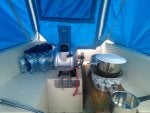
Snorri you mention lots of weed growth on the outboard. How does your hull look? Moderate to significant growth on your hull creates a ton of drag. Enough drag to drop you down 1-2 knots in hull speed.

That?s a fair question waterrat. I?ve hit the hull with a long handled scrub brush from the dinghy three times over the summer. I think it?s not perfect but ok. I?ve also cleaned the motor several times but I?t is annoying. For my last long sail (long for me, 24 nautical miles) I did just pull the motor. No locker big enough so I set I?t on the cabin sole. Didn?t have to drag a weedy prop behind me all the way. Maybe that?s the only good solution for the time being. Keeping I?t out of the well when at the Mooring should keep I?t perfectly clean. Just adds to the getting underway process if I can?t sail off the mooring. Appreciate all of the thoughtful input.
Yikes! That's a lot of crap to drag along. Probably explains your slow problems. If slowness still persists, I'd suggest contacting a Yamaha dealer and see if they can get you a prop suited to a displacement boat. Most small OB's are not propped correctly for sailboats (except the Tohatsu SailPro motors). A high thrust prop makes a huge difference, especially in reverse.
I had a small boat similar to yours with a motor in the well. Short story is that I loved it. For a small boat a 5hp outboard should have no problems getting you to speed, and is much easier to maintain (or replace) than an inboard. Having it in the well meant it was easy to operate singlehanded while also steering the boat. Best part of all, I was able to turn the motor in the well and use it like a bowthruster - making tight maneuvers easy in my long keel boat. Hanging it off the back, the motor will be difficult to access as you are motoring, and can cavitate out of the water. It also looks horrible. I regularly pulled mine out of the water when at the slip, and I had a Tohatsu with the high-thrust prop.
- ?
- 173.9K members
Top Contributors this Month
Islander Sailboat
Islander Sailboats .com .ca .net .org .info .etc

Islander 21 Motor Well
There are a few names for a Transom Well, Motor Well, Inboard Outboard Well, Engine Mount Well, and I’m sure there are others. I wanted to post a few more pictures of the engine mount well in my Islander 21′ sailboat for the folks at the Facebook Islander Sailboat Owners group .
Here’s my old 1967 Johnson 6hp outboard in the engine mount well:

Here’s my Dad working around the new 2014 Suzuki 6hp outboard in action in the motor well. The echo of the motor in the empty cabin below decks can be a bit loud, and the tiller doesn’t rest nicely, but (especially solo) it’s much easier to manhandle the outboard in the cockpit rather than out over the stern:

The well from the top shows its rectangular shape:

I didn’t measure too carefully, but it seems the bottom tapers in a bit:

This is a picture looking straight up from below, I like it because of the blues and whites. Also notice the lip all the way around where the bottom plate must have fit:

My buddy Jon was stomping on the top plate to keep the chop from splashing into the cockpit, and has his right hand out the back on the outboard tiller handle when the engine was on the transom outboard motor mount. Notice the top plate has small hole next to the cleat / handle. I think a bolt went down and attached to the bottom plate to hold it in place there, and perhaps a previous owner unbolted it at the wrong time and lost the bottom plate:

Here’s a fantastic article on how to create an outboard motor well http://www.atomvoyages.com/articles/improvement-projects/249-outboard-1.html
And there’s a lively discussion here on the pros and cons of the motor well http://forum.woodenboat.com/showthread.php?148251-Outboard-motor-wells
Share this:
- Click to share on Pinterest (Opens in new window)
- Click to share on Twitter (Opens in new window)
- Click to share on LinkedIn (Opens in new window)
- Click to share on Facebook (Opens in new window)
- Click to share on Tumblr (Opens in new window)
- Click to email a link to a friend (Opens in new window)
- Click to print (Opens in new window)
Published by
Islander admin.
The primary web site administrator. View all posts by Islander Admin
2 thoughts on “Islander 21 Motor Well”
Back in the late 1970s I had an Islander 21. It came with a fitted fiberglass “bucket” to fill the outboard well when it wasn’t in use. I wasn’t crazy about the 2-stroke exhaust from the Johnson 6 long shaft outboard, which flowed up from the well, filled the cockpit, and eventually flowed over the edge. Maybe my outboard was especially smokey! While living in Saratoga Springs, I had Scarano Boat Works install a Volvo Penta Sail Drive in the boat where the outboard well was. The engine was a Honda 10 HP outboard powerhead mated to a through-hull lower unit. It worked very well indeed and was a wonderful change- it had a proper engine single-lever control for forward-reverse and speed. The prop was right in front of the rudder and gave great control. It was a sweet rig.
Thanks for sharing that Earl, that sounds amazing! If you ever dig up any old photos please let me know.
Leave a Reply Cancel reply
Your email address will not be published. Required fields are marked *
Notify me of follow-up comments by email.
Notify me of new posts by email.

The Best Outboard Motor for a Sailboat

Last Updated by
Daniel Wade
June 15, 2022
The technology of sailing has remained mostly unchanged for centuries. Since learning to harness the power of wind, sailors have been transiting the world’s oceans, expanding trade routes and exploring new cultures. Although nothing more than a renewable natural resource and a single sail is needed to move a sailboat along the water, there are times when it’s important (and in our modern age, convenient) to leverage off a motor to get you where you need to go.
Like any unique piece of equipment in the world of sailing, outboard motors come in a variety of sizes with features and options to fit any owner’s needs. But of course, one size doesn’t fit all. Every boat is different – even those that come off the production line at the same time – and every owner is looking for something specific when it comes to their sailboat. From the purpose of owning the boat (blue water sailing vs. racing) to the location and impact on maintenance (cold weather vs. tropical weather), an outboard motor is just one of the many elements that will define a sailboat’s function and performance.
Whether you’re a new owner, or a veteran sailor, it’s important to know the basic components of any outboard motor . You should also have an idea of what you want your outboard motor to do for your size and model sailboat.
Table of contents
Outboard Motor Size
A larger boat doesn’t necessarily mean a larger motor. Although there are different ratings for different classes of boats, a small power plant can be more effective than a larger one. Conversely, an outboard motor can easily overpower a small boat and create unsafe conditions at high speeds. Guidelines and requirements differ between motorboats and sailboats. And while there is some overlap, these considerations apply directly to sailboats.
Engine power has to do with how much water a boat displaces. For sailboats, smaller is better. If you’re a bit of a math geek, the exact formula is 4 horsepower for every 2200lb of weight. Coupled with a propeller size, which can be determined using a propeller calculator , you’ll get a rough estimate to use as a guideline to start shopping. This is a good first step, since size is essentially a fixed variable. Though it’s worth noting for those who are buying a sailboat directly from the manufacturer, that actual weight will increase after delivery – once all other rigging and outfitting has been completed.
Physical size of your outboard motor is an important consideration and is directly related to the design of your sailboat. An outboard motor is made up of three parts from top to bottom:
- The Powerhead – Houses the engine. The bulbous part of the motor.
- The Midsection – Houses the exhaust system. Varies in length and design.
- The Lower Unit – Propellers attach to the gearbox. Submerged when operational.
Shaft length is an important design element and should be considered when purchasing a motor. A shaft that is too short will obviously prevent the propeller from being submerged in water, while a shaft that is too long will extend the propellers too far. Not only will it decrease the efficiency of your engine, it will create unnecessary drag. Know your transom length when looking at different models.
When an outboard motor is not being used, it should be stowed in its upright position. Some of the larger motors have an automated switch that will raise it out of the water, but some must be secured manually. Make sure everyone who sails with you is capable of lifting and securing the motor out of the water in case of an emergency.
Outboard Motor Power
Any kind of motor installed on a sailboat (inboard or outboard) should be viewed as a tool to help with maneuvering. Although there are some very skilled sailors out there who can sail into their slip without the aid of a motor, many harbors have restrictions that either don’t allow for the use of full sails, or there simply isn’t enough room to maneuver. A motor with both forward and reverse gears helps tremendously with docking.
While there is no exact correlation between boat length and total weight, the following is a rough guideline:
- 1-4 HP for boats up to 20’ (approximately 1000-2000lbs)
- 4-18 HP for boats between 20-30’ (approximately 2,000-10,000lbs)
- 18-34 HP for boats between 30-40’ (10,000lbs or more)
There are some things to consider when deciding how much horsepower you need or want. Location and the type of conditions you expect you’ll be sailing in is one of the biggest factors. Heavy seas and high winds typically associated with open ocean sailing will put more strain on your engine, and in some cases overpower it, whereas an engine that is heavier than needed will add unnecessary weight when racing. If you plan on motoring for long distances, consider purchasing an engine that will stand up to a lot of use.
Less HP is required for:
- Boat Design – Single hull boats made out of fiberglass require less power.
- 2-Stroke Engines – This is due to an overall lighter weight engine and higher torque.
- Diesel Engines – Diesel delivers more torque because the rate of compression is greater.
- Bigger Propellers – More surface area means more water displacement.
- Location – Motoring on lakes and rivers requires less power than open ocean.
- Distance – A smaller engine is suitable for shorter distances.
More HP is required for:
- Boat Design – Catamarans and heavier boats (regardless of size) require more power.
- 4-Stroke Engine – Engine weight and an extra step of compression yields less power.
- Gas Engines – The rate of compression for gas engines is much lower than diesel.
- Smaller Propeller – A smaller propeller displaces less water.
- Location – Open ocean, with tides and currents, will strain a smaller engine.
- Distance – Cover more distance when wind conditions are poor requires a larger engine.
Outboard Motor Cost
There is no way to quantify how much you will pay for any given motor. But there are several costs associated with owning an outboard motor that are definitely worth considering when making your purchase.
Certainly, a lager, more-powerful engine is going to be costlier than a smaller engine with lower horsepower. But as mentioned earlier, size is not necessarily a guarantee of performance and efficiency. At the same time, there’s only so much you can get out of an engine before you exceed its capability. Larger engines tend to help with resale value should you choose to sell your boat at some point, but a boat outfitted with right motor to begin with will always perform better than a motor that’s large just for the sake of it.
Factor in maintenance costs and fuel when looking at models. You want to run your engine at around 90% of its max RPMs to balance proper fuel usage and with wear and tear. Making a few calls to marine mechanics to inquire about an engine you’re interested in will give you a lot of information a sales person won’t be able to give you. The good news about outboard motors is that most of them are portable, which means you won’t have the added cost of either paying a mechanic to come to you, or having to get your boat to the yard, which usually requires help from a very good friend willing to spend all day driving and sailing back and forth.
Owning a boat requires constant care and maintenance, so a little knowledge goes a long way. While an outboard motor is not required for sailing, it’s a convenient addition that can greatly increase your enjoyment out on the water. Being patient and spending time researching engines will not only help you make the correct purchase but will help you take advantage of a great deal when it presents itself. Whether you sail the Caribbean, or race off the coast of California in a catamaran, there is an outboard motor that’s just right for you.
Related Articles
I've personally had thousands of questions about sailing and sailboats over the years. As I learn and experience sailing, and the community, I share the answers that work and make sense to me, here on Life of Sailing.
by this author
Sailboat Upgrades
Most Recent

What Does "Sailing By The Lee" Mean?
October 3, 2023

The Best Sailing Schools And Programs: Reviews & Ratings
September 26, 2023
Important Legal Info
Lifeofsailing.com is a participant in the Amazon Services LLC Associates Program, an affiliate advertising program designed to provide a means for sites to earn advertising fees by advertising and linking to Amazon. This site also participates in other affiliate programs and is compensated for referring traffic and business to these companies.
Similar Posts

How To Choose The Right Sailing Instructor
August 16, 2023

Cost To Sail Around The World
May 16, 2023

Small Sailboat Sizes: A Complete Guide
October 30, 2022
Popular Posts

Best Liveaboard Catamaran Sailboats
December 28, 2023

Can a Novice Sail Around the World?
Elizabeth O'Malley

4 Best Electric Outboard Motors

How Long Did It Take The Vikings To Sail To England?

10 Best Sailboat Brands (And Why)
December 20, 2023

7 Best Places To Liveaboard A Sailboat
Get the best sailing content.
Top Rated Posts
Lifeofsailing.com is a participant in the Amazon Services LLC Associates Program, an affiliate advertising program designed to provide a means for sites to earn advertising fees by advertising and linking to Amazon. This site also participates in other affiliate programs and is compensated for referring traffic and business to these companies. (866) 342-SAIL
© 2024 Life of Sailing Email: [email protected] Address: 11816 Inwood Rd #3024 Dallas, TX 75244 Disclaimer Privacy Policy
How to Calculate Outboard Motor Size for Sailboats
It seems so complex to pick the right engine size for your sailboat. I was done with complex calculations and tried to make it easier here.
How to pick the right outboard motor size for your sailboat? To get the right amount of horsepower needed to efficiently propel a sailboat, divide the displacement of the boat (in lb) by 550. You need approximately 1 HP per 550 lb of displacement or 4 HP per 2200 lb. Most sailboats don't need a motor with more than 30 HP.
In this article, I'm talking about small outboard engines for sailboats. We're talking about displacement hulls here, so in other words: keel boats. They need more power than flat bottoms.
But they're not powerboats - so it's not our mission to go fast. It's our mission to get decent speed, good control over the boat, and the best possible fuel efficiency. Without breaking the bank of course.
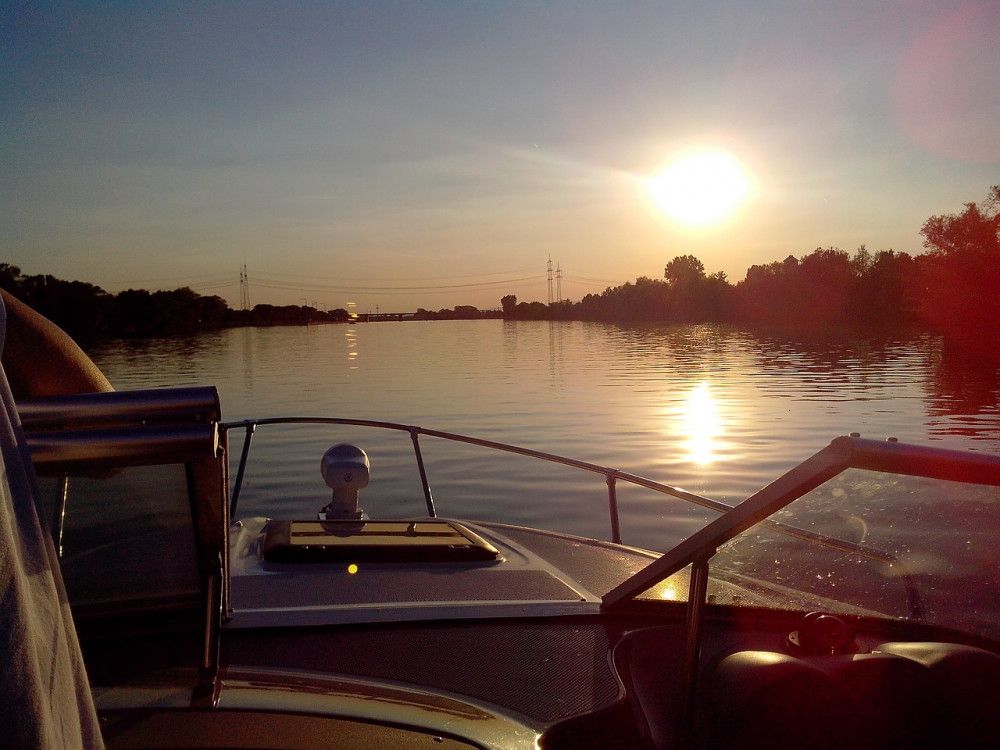
On this page:
How to pick the right motor size, other factors that are important for size, why is the right motor size important, is there a max hp for sailboats, in conclusion, related questions.
Sailboats need way smaller engines than powerboats. That's great news (unless your ultimate goal is speed), because it's cheaper to buy, cheaper to drive, and cheaper to maintain.
The amount of power you need is related to the hull displacement of your boat.
I like to use the simple formula:
HP = displacement (lb) / 550
So 1 HP for every 550 lb displacement, and 4 hp per 2200 lb.
Here, HP is the amount of horsepower you need to reach the maximum hull speed. This is in optimal conditions. So you have smooth water, no windage, a clean and polished hull, and so on.
If you want to get it absolutely right, you also need to correct for propellor size. And of course, a lot of other factors come into play (more on that later). But generally, these engine sizes will work with the following weights:
That sounds about right to me. But remember that these are all rough estimates: I just try to give you a ballpark figure. There is no one formula to get an exact number. The hull design, sailing conditions, and your personal preference are all very important.
If you're serious about getting a new engine, I definitely recommend to get advice from an expert . But you know, salespeople always recommend the Turbo version. Remember that you don't have to overpower a sailboat. Usually you don't need anything over 30 HP. So at least you now know what will work on average.
What is hull displacement?
- Hull displacement is the weight of the boat, or the amount of water the boat displaces.
- Maximum hull displacement is the weight of the boat when it's fully loaded, including crew.
The weight of the boat is the same as its displacement, because the weight of any object is exactly equal to the weight of the water it displaces (aka: pushes aside). This is called Archimedes Principle.
The weight slightly differs in saltwater from freshwater, because saltwater is heavier. In saltwater, the boat gets a bit lighter. So in theory you can use a smaller engine for a bluewater boat, but in practice this is offset by the stronger current and wind.
How to find the displacement of your boat?
Most manufacturers simply give you the displacement of your boat. If you can't find any data, because, for example, you own an old boat, you can weigh your boat on a truck scale. You can also haul it out and measure it (which is painstaking work).**
Tip: if you're gonna weigh your boat, simply drive it onto a truck scale, and retract the weight of the trailer from the total weight.
Of course, it's not so simple. This formula gives a rough estimate. But for me this was way clearer than all that black magic that I get when I ask people what size engine I should get.
Let's look at the things this formula doesn't take into account.
2-strokes are more powerful than 4-strokes. Two-stroke engines fire once every revolution and four-strokes fire once every other revolution. This makes the 2-stroke twice as powerful. They provide more torque at a higher RPM. But they also wear more quickly. The 4-stroke will last you a lot longer, and its also more fuel efficient.
The right propellor size is just as important as having enough horsepower. With a smaller prop diameter, it has to work harder to generate the same propulsion as a larger diameter. But you can't just go larger always. The prop affects the RPM of your engine, and you have to get in the right range (more on this later). You also have to check the maximum diameter that fits your boat.
Diesels have more torque, because the compression rate is higher than that of gasoline engines. So if you consider a diesel, you can do with less HPs.
High windage hulls (multihulls) need a bit more. A multihull (or larger hull in general) suffers from more friction because of the larger surface. So the engine needs to work a little harder.
If you sail longer distances under power , or against the wind it's a good idea to get a larger engine (but not too large). This helps you to save on fuel since you have lower RPM. Especially if you sail offshore or on open sea. The engine needs to work harder due to stronger wind and current.
If you're just sailing in and out of the marina under power, you may need less HP.
Smooth hull designs need less HPs than bulky hull designs, like the classic wooden clippers and crabbers for example.
It matters to get the right size outboard motor for a couple of reasons.
First of all: smaller engines are cheaper, so you save money on buying the engine.
Secondly: smaller engines use a lot less fuel, so you save money on using the engine.
Thirdly: smaller engines are cheaper to maintain: so you save money on maintenance.
So why not get the smallest engine and get the best fuel economy? There are a couple of advantages to getting a (slightly) bigger engine:
- More power means more control (easier to stop the boat, in case you need to)
- Finding the sweet spot might actually reduce fuel consumption
The sweet spot
To perform optimally, an engine should get up to speed. The problem with an overpowered boat is that the engine won't rev up to 80 - 90% of the RPM. This kills fuel efficiency and also the cooling system won't operate optimally.
- The optimal cruising RPM of the engine is about 85-95% of the maximal RPM
- You should reach cruising RPM at hull speed, so your engine should be at about 90% RPM
The propeller size is very important for the RPM. If your prop diameter is too wide, the engine can't get up to speed and struggles to build power. Bad for fuel economy, bad for the engine, and bad for performance.
On the other hand, if your prop is too small, you don't make use of the engine's full power.
If you struggle to get to high RPM, your prop is too large. If your engine is constantly in the red, you're underpropped.
So don't go too big on the prop, but also don't go too small. The easiest way to get it right is to check the engines manual and see what the manufacturer recommends.
You can definitely go too big on a sailboats engine. An overpowered yacht doesn't make any sense. True, it can look cool, but it can't feel cool. Every displacement hull has a maximum hull speed. That means that it cannot go any faster than the max speed. So if your engine can cruise at that speed, it's not getting any better.
The problem with displacement hulls is that they displace the water, or in other words: they push the water in front of them. They cannot move any faster than they can push away the water. And because the resistance increases as speed increases, there's an absolute, physical speed limit for each keelboat.
That's why powerboats have to get out of the water to reach top speed.
Fun fact: the longer your boat, the higher the hull speed. Want to know the maximum hull speed for your boat? You can find it in this article .
So, you can't go faster than your maximum hull speed, so a 50+HP engine is kind of ridiculous. Bear in mind that a large engine also has the following disadvantages:
First of all: larger engines are more expensive, so you spend more money when buying the engine.
Secondly: larger engines use a lot more fuel, so you spend more money when using the engine.
Thirdly: larger engines are more expensive to maintain: so you spend more money on maintenance.
Also, if your engine is too big, it doesn't reach the optimal cruising RPM, so your fuel economy also gets really bad FAST.
I suggest getting the smallest possible engine that gets you to maximum hull speed while it's at roughly 90% of the RPM. As long as it gives you enough control and good handling, it will get you there. If you give up on going fast, you can actually get really good fuel economy and your engine will last you probably 20 years.
If you want to go fast, a sailboat is not the right one for you. You should instead get a powerboat.
I'm just kidding. Read my 13 Reasons Why Sailing is Better Than Powerboating here .
Do sailboats have motors? Most sailboats are power assisted boats, which means they have a small auxiliary engine to cruise in light air. When a sailboat is sailing under engine power, it is considered a motorboat and it doesn't have right of way.
Thanks for answering my questions.
Taylor Bishop
Thanks for explaining how you can figure out what size you need for an outboard motor. You mentioned that you should find the displacement by weigh a boat on a truck scale. I’m interesting to learn if you need to regularly weigh it in case the hull displacement could change or if it will always be consistent.
Shawn Buckles
Hi MitI, you’re welcome, my pleasure.
Hi Taylor, my pleasure.
You don’t need to weigh your boat regularly, as the hull displacement will stay consistent. You could literally see the hull displacement as the amount of space your hull takes up in the water. So as long as you don’t make any major changes to the hull shape or ballast of your boat, you should see no differences in displacement.
Roger S Johnson
How do you measure for shaft size, most outboard motors are for flat bottom and say measure to the bottom of the boat, most sailboats tapper to the aft. Where do you measure for a tapered bottom sail boat?
Will a 5 horse Honda 4 stroke be ok for a 25 foot Pearson Commander sail boat. Thanks for your time Luke
I think it would be Luke.
Great post, thanks for the info. A naive question from a soon-to-be sailor: I’m considering buying a 28 ft sailboat, with 2500 kg (ca. 5500 lbs) displacement. The engine is in pretty good condition, but is old and the original one (from 1977!), so I am also thinking of an alternative scenario in which it fails. I know that in my area replacing an inboard engine will cost double the price I’m putting down for the boat, and since I’m on a budget, that simply won’t be an option and outboards seem to be cheaper. So the question is: is it possible to put an outboard engine on all boats? Is there some factor that would make it impossible to mount an outboard engine on the boat? Thanks!
Garth Powelson
What is minimum length that a sailboat can go without an outboard. Does a 29’ “require by law” to have engine?
Hello Mr. Buckles, Thanks for the informative article. I’m looking to get the smallest possible outboard for my 1.5 ton displacement fiberglass monohull Hood 23’ sloop. Can I get away with a 4HP?!? What size prop would I need?!? (I’m only going to use it when there is NO wind, and, if I can stay 4HP or below, I am not required to register my vessel—which is pretty cool, so here’s hoping!)
Thanks again, Ship
Hi, I’ve got a older Pearson 39’ . I’m looking to remove the old 40 ho westerbeke and go electric. Unsure of what hp is going to be needed?
emilio h javier
i am purchasing a catalina 22 ft. i have in mind a 4 HP motor. what would be the length of the shaft.
I am considering buying a 25 ft sailboat with a 7200 lb displacement. The boats top speed is listed at 7knots per hour but the diesel motor does not work. The owner has a 9.9hp outboard that can be purchased with the boat. Is 9.9hp enough to power the boat to at least 5 to 6 knots per hour? Thanks. Rick
What weight outboard would be too much for a 20’ Santana, displacement 1,350 lbs? I don’t want too much weight at the back. I want the boat to be seaworthy.
I have not seen this amount of BS in years :) I’m not a marine engineer, yet physicist & avation engineer. You even can’t tell the difference between mass of the vessel and diplacement :D Fcking genius.
Leave a comment
You may also like, what’s the life expectancy of a marine diesel engine.
Being a fan of the waters, I found the life expectancy of marine diesel engines an interesting topic to deeply research. I went on and on and I couldn’t stop …

How Much Fuel Does a Sailboat Use?
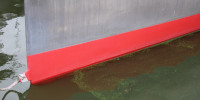
How Often Should You Antifoul a Boat?
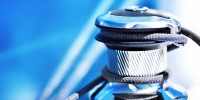
3 Ways to Convert Your Winches to Self-Tailing
Own your first boat within a year on any budget.
A sailboat doesn't have to be expensive if you know what you're doing. If you want to learn how to make your sailing dream reality within a year, leave your email and I'll send you free updates . I don't like spam - I will only send helpful content.
Ready to Own Your First Boat?
Just tell us the best email address to send your tips to:
- Spirit 1.0 Plus
- Spirit 1.0 Evo
- Pod Drive Evo
- E-Series Battery
- G102-100 Battery
- Find a Dealer
- Have a Dealer Contact Me
- Product Registration
- Support Center: FAQ & Guide
- Video Tutorial
- Download Center
- Performance Bulletins

Electric Sailboat Motor: Range, Cost, Best Kits for Conversion
Today, owning a completely green sailboat has been made possible with electric sailboat motors.
Imagine cruising with the silence of an electric sailboat motor and the ease of use with a simple press on the start button. What’s better is there are no exhaust fumes at all with significantly less maintenance.
It’s so appealing that a lot of sailing liveaboards have made their electric sailboat motor conversion.
However, some sailors are still on the fence, worrying about the range and price of the electric sailboat motor.
If you are one of them, you are in the right place!
This post will guide you through every aspect you need to know about electric sailboat motors to help you make an informed decision.
Besides, you will get professional insights on how to make the electric sailboat motor conversion for your own boat and learn the best electric sailboat motors (with honest reviews).
Table of contents:
- Electric Sailboat Motors: Confusion Explained
Electric Sailboat Motor or Combustion Motor
- Electric Yacht Motor Conversion: Two Solutions
- How to Size an Electric Sailboat Motor
Best Electric Sailboat Motors (with Reviews)
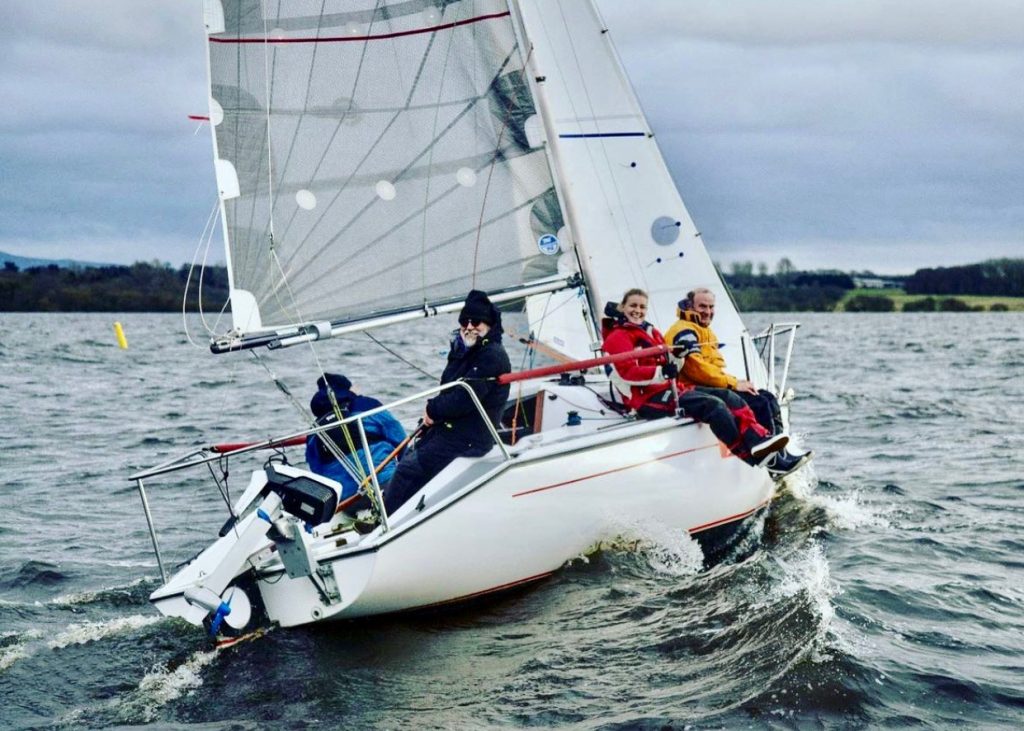
Electric Sailboat Motor: Confusion Explained
Can you go cruising with an electric sailboat motor? Can you put an electric motor on a sailboat? Are there any limitations?
Whether electric sailboat motors are a good fit for your boat is not a YES or NO question. Here we will explain your top worries with statistics and facts. That way, you can make a wise decision according to your situation.
You may hear some complaints about the batteries and range of the electric propulsion.
However, their experience may not suit electric sailboat motors.
In fact, even small electric engines work pretty well in many sailboats. That’s because most of the time, the wind can power the boat, and the motor is just used for docking or in rare times when there is no wind.
Therefore, it makes more sense to learn electric sailboat motor performance in real-world applications.
Here is a test report of a 3 HP electric sailboat motor on an RS21 racing sailboat:
As you can see, the small electric sailboat motor can run at 5.5 mph top speed for one hour continuously.
And there is a big difference in terms of range vs speed for electric sailboat motors:
If you lower the speed, the range and runtime can be greatly extended. The slower you go, the further you’ll get. For example, if you cut your speed in half, the electric sailboat motor can last 7 hours and go 20 miles within one charge.
That’s pretty sufficient if you use the electric yacht motor mostly for docking or as an auxiliary engine.
Faster top speed (and more range) is available with higher power electric sailboat motors depending on your specific requirements. Contact a specialist to design your electric sailboat motor solutions.
Also, don’t forget to get the electric sailboat motor with regeneration (See recommendations below).
That’s to say, when there is a lot of wind and you’re moving rapidly via your sails, they regenerate and store electric power on the batteries to keep you moving at other times. Solar recharging is also a plus.
Essentially, the range depends on how many batteries you have, so it’s not a limitation of electric sailboat motors but energy and batteries.
If you are still worried, you can offset this by getting a diesel generator, which is more efficient than a diesel engine. And it is a range extender when you need it, but for 90% of your motoring that you don’t need the range, you can rely on the electric sailboat motor.
Some of you might be concerned about the extra weight of the batteries.
In fact, an electric sailboat motor with lithium batteries weighs less than a diesel engine, particularly if you include the fuel weight.
If you want a lightweight electric sailboat motor solution, make sure you get one with LiFePO4 batteries . Compared with other marine batteries, they are more compact in design with much less weight and higher energy density.
Some more advanced electric motors for small sailboats (such as Spirit 1.0 Evo) feature an integrated lightweight battery. So you don’t need to worry about the complex wiring to hook it up or extra space to store the battery.
This is a huge plus if you want to use the electric sailboat motor on a tender or dinghy.
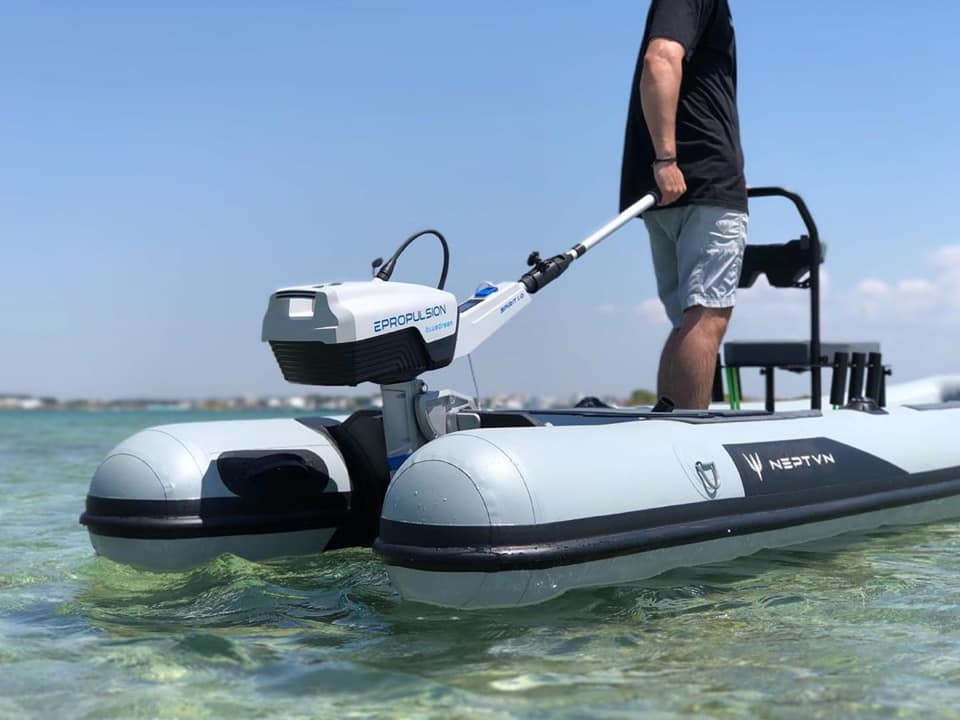
Here is also a chart that collects the weight of some popular electric sailboat motors for your reference:
For many people, another big problem with electric sailboat motors is the cost.
It’s true that a gasoline outboard with similar power is a lot cheaper to buy. However, the electric sailboat motor eventually wins in long-term operating cost. That’s especially the case if you are going to do a lot of motoring.
Electric sailboat motors save on fuel and maintenance costs, which can build up to a large amount over time.
Here is a chart that compares the cost of a 3HP electric sailboat motor (coming with a built-in battery) with its combustion counterpart:
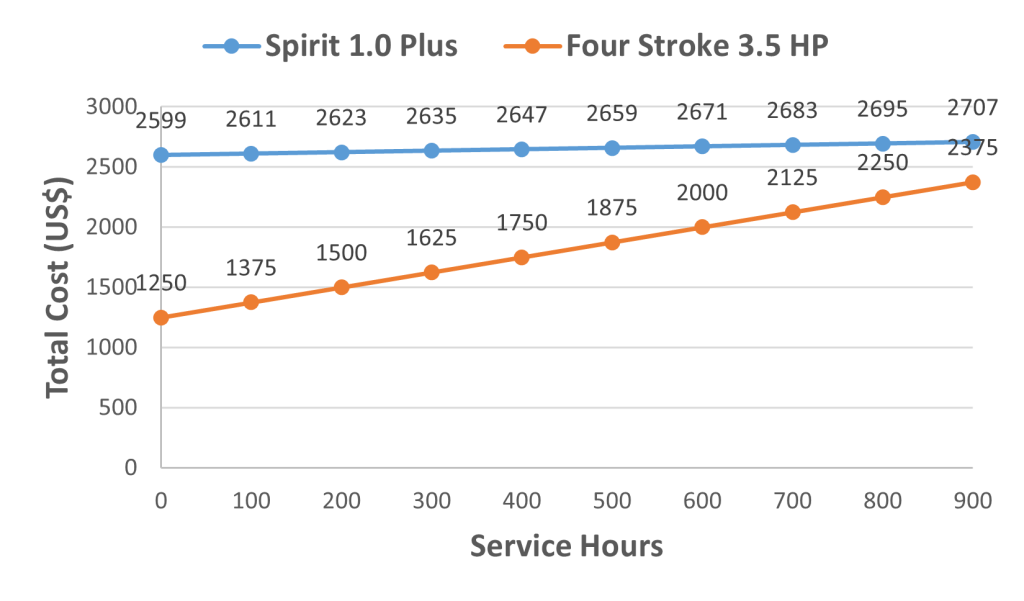
That’s to say, you will cover the price difference for electric yacht motors eventually as long as you use it long enough. Click to check the details of the calculation .
What makes the electric sailboat motor even more worthwhile is it saves you a lot of hassles, especially for sailors who only use the engine in and out of the harbor. Dealing with the maintenance of the gas outboard for a 10 minute motor out of and into the harbor is disproportionate and painful.
*The higher horsepower electric sailboat motor may be different in terms of the cost calculation. Check out the outboard motor pricelist by HP for more information.
As you may have already noticed, electric propulsion has already been widely used in the marine industry:
It’s quiet while motoring, clean to handle, environmentally friendly, with less maintenance and operation costs.
The electric sailboat motors are easier to use with dramatically fewer moving parts to break and no worries about being a diesel mechanic to deal with the hard pulling start. You can have it always on, so it is ready whenever you need it.
And it makes even more sense in sailing applications:
You don’t really need to motor much if your plan is to actually sail. If you are completely becalmed, you will probably just need to motor at 2 knots to keep making way, which is easy for electric sailboat motors.
If you mostly use the motor to get into and out of the harbor, the electric sailboat motor also works great for you.
You can always charge up at the dock, motor out of the marina (or even motor to your sailing area or race start), then hoist the sails and when you’re through, the batteries are charged again.
The electric sailboat motor is also useful as a backup (kicker) motor in case your system goes down. That’s why you can see people pushing a lot of big boats with small electric motors. (Click to learn more information about kicker motors .)
Personally, it’s really nice to have an electric auxiliary in the boat – no smelly, messy diesel and motor oil to deal with, a much simpler system with less maintenance, and much, much quieter operation.
However, powerboats tend to have much higher requirements in terms of both power output and runtime. In that case, an electric sailboat motor can be hard to satisfy your needs.
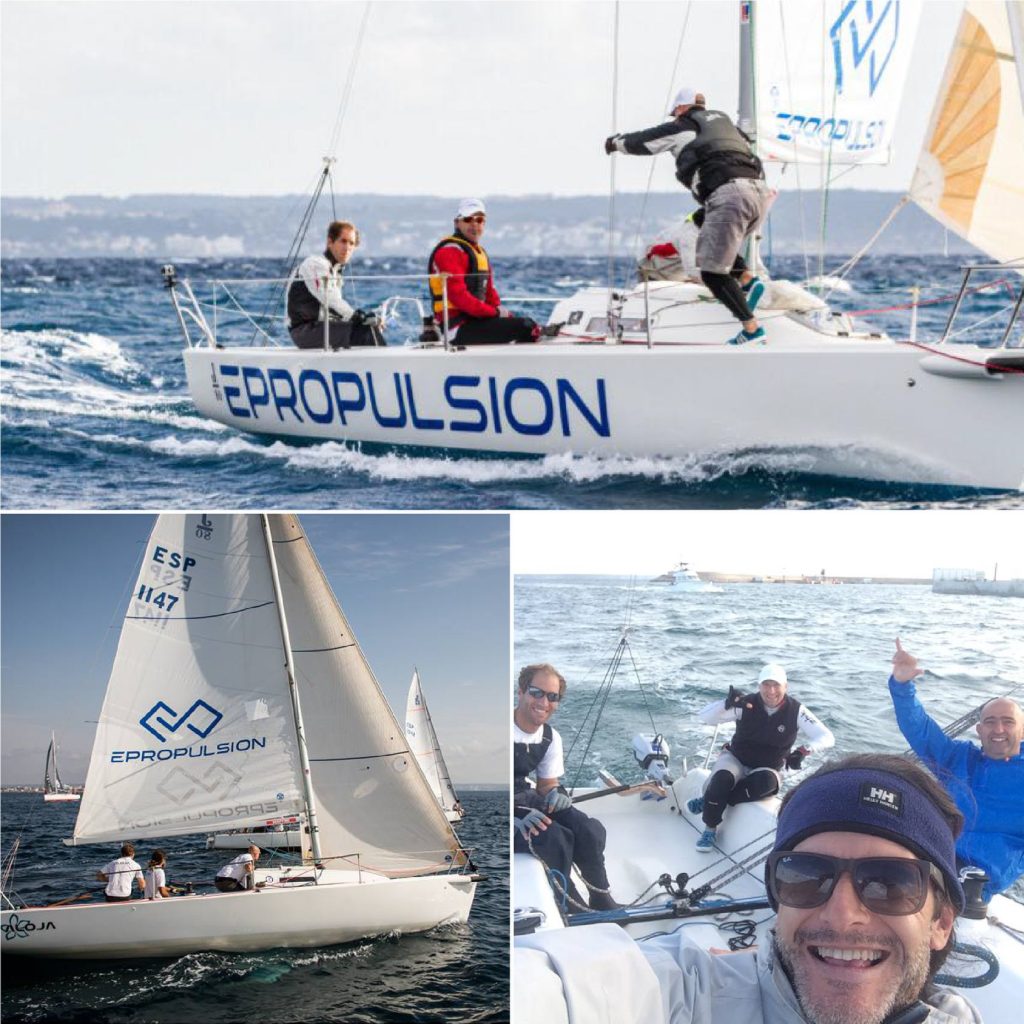
How Do You Size an Electric Motor for a Sailboat?
As a rule of thumb, you will need approximately 1 HP per 550 lb of the displacement of your boat.
Generally speaking, a 3 HP electric sailboat motor can push a sailboat up to 25 ft and a 9.9 HP motor is sufficient for a 30 ft sailboat to motor at a satisfying speed.
However, bear in mind the horsepower you need always depends on your needs and applications.
It’s better to check the data from real-world tests to decide whether the electric sailboat motor is suitable for your specific needs.
For example, the 9.9 HP electric sailboat motor Navy 6.0 allows you to go at 6.9 mph (11.1 kph) on a 30 ft sailboat, and the range can be extended to 46.4 miles if you decrease your speed to 2.9 mph (4.6 kph).
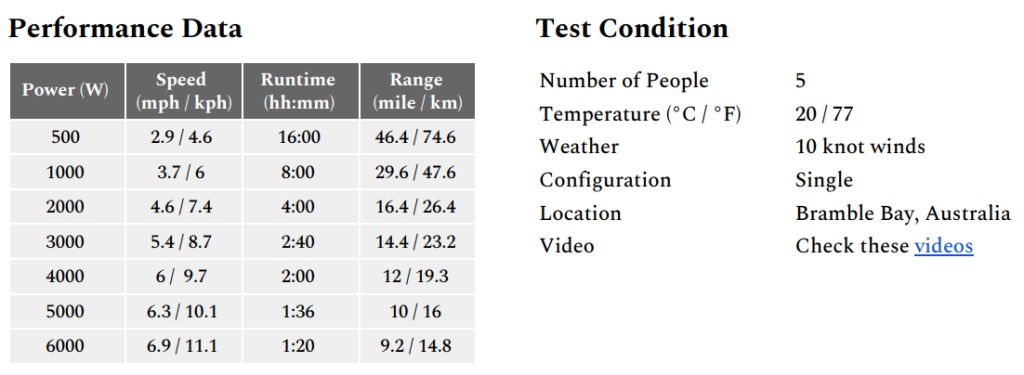
Click to see more test reports with other electric motor and sailboat combinations, and find the electric sailboat motor that suits you best.
If you are still not sure about the size of the electric sailboat motor for you, feel free to leave us a comment and we will get back to you ASAP with professional suggestions.
Electric Sailboat Motor Conversion
Basically, there are two ways for you to convert your sailboat to a clean and quiet electric drive system:
You can either convert your current vessel to electric or buy an engineless yacht and install an electric sailboat motor on your own.
#1. Repower Your Sailboat with Electric Motor
If you decide to replace the diesel engine with an electric motor, you will need to do a lot of preparations:
The DIY approach requires an electric sailboat motor kit (including motor and controller), batteries, a good level of mechanical ability and basic electrical knowledge, as well as some common tools such as a voltmeter.
You will need to take the old engine out for the new electric sailboat motor installation. It’s not an easy task that involves removing the engine mounts and the drive shaft (dealing with the numerous hoses and cables), taking out the engine, exhaust system, fuel tank, and its attendant tubes, etc.
Remember to balance the boat to avoid listing during the electric sailboat motor conversion.
Then in with the new electric sailboat motor. The installation process can be straightforward if you choose the electric sailboat motor kit wisely (See steps below). Furthermore, you can set up solar charging for your electric sailboat motor with solar panels and charger.
Many sailors have recorded their electric sailboat motor conversion process and experience. Be sure to check them out to get some inspiration. For example, Ed Phillips has documented everything which can serve as a guide for newbies to get started.
Mind you there can be a whole heap that can go wrong in designing and maintaining the electric sailboat motor systems. You really need to be totally on top of it if you want decent performance or reliability.
If you are not that technically inclined, it’s better to talk to a specialist first to discuss your plan for a smooth electric sailboat motor conversion.
#2. Install an Electric Motor in a Sailboat
If you own an enginless sailboat, the electric sailboat motor conversion is much easier for you.
All you need to do is to find a reliable electric sailboat motor and install it in simple steps. The whole process can be easily done, even for beginners. Here we take the popular 6 HP electric sailboat motor Navy 3.0 as an example to show you the installation process:
- Step 1 : Rotate the clamps or use the screws to fix the outboard onto the sailboat.
- Step 2: Mount the steering system in the proper position.
- Step 3: Install the tiller on the electric sailboat motor.
- Step 4: Connect the batteries to the electric sailboat motor system.
Click to check the video tutorial that guides you through each step of the installation.
If you are worried about aesthetic issues and want higher horsepower options, an electric inboard motor can be a better suit for your sailboat. If you prefer an inboard motor for your sailboat, contact our OEM team to get an electric propulsion solution tailored to your needs.
Note : You might find some electric trolling motors rated by #s of thrust on the market. Actually, those electric trolling motors for sailboats can only provide limited speed and range. If you are heading into the wind, the trolling motors for sailboats are definitely not an ideal solution.
Once you’ve evaluated if electric sailboat motors are right for you, there are a lot of options for electric systems.
Here are some popular electric sailboat motors with positive reviews from customers worldwide. Fast charger is available for all the models recommended to reduce your charging stress.
#1. 3 HP Spirit 1.0 Evo
If you are looking for an electric motor for a small sailboat, be sure to check out the ePropulsion Spirit 1.0 Evo. It’s suitable for large daysailers or small cruising sailboats under 25 ft.
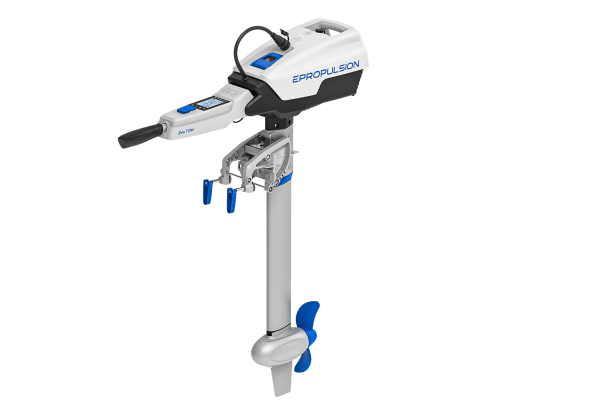
With the Spirit 1.0 Evo electric sailboat motor, you can go 5.5 mph (8.8 kph) at top speed on the 21 ft RS21 sailing boat, or troll for 20 hours continuously at 2.2 mph (3.5 kph) according to our test .
This electric sailboat motor with regeneration allows you to recover energy from the prop while under sail. It will start to generate power automatically when the sailing speed reaches 2 knots.
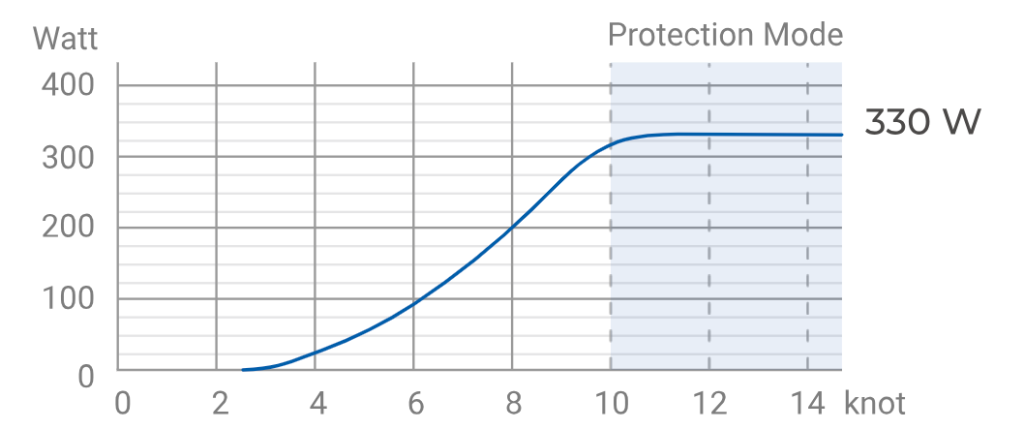
As an electric auxiliary sailboat motor, it can also be easily installed on your tender boats or yacht dinghies since it’s portable and easy to transport (with a lightweight integrated battery).
Features You Will Love:
- Come with the industry-first hydrogeneration capability
- Direct-drive technology makes it maintenance-free
- Portable with a 1276Wh large integrated lithium battery for long range
- Safety wristband keeps you safe in case of MOB
- Digital operation keeps you informed of the battery status
Spirit 1.0 Evo Electric Sailboat Motor Reviews:
“Great weekend with my 17′ sailboat powered by the Spirit Evo. This is great. Quiet and reliable. Went at 3/4 throttle for about 1.5hrs when taking it back to boat ramp.” – Robert Taylor
“Very happy with our Spirit Plus. Pushing our Kolibri 560 a 750 Kg sailboat, with ease. Doing about 5.8 km/h at 500W.” – Frank van Asten
#2. 6HP/9.9 HP Navy Evo Series
If you want a little more juice on the electric sailboat motor, check out the ePropulsion Navy Series. It offers 6 HP and 9.9 HP models for your selection and it provides sufficient power for sailboats up to 30 ft.
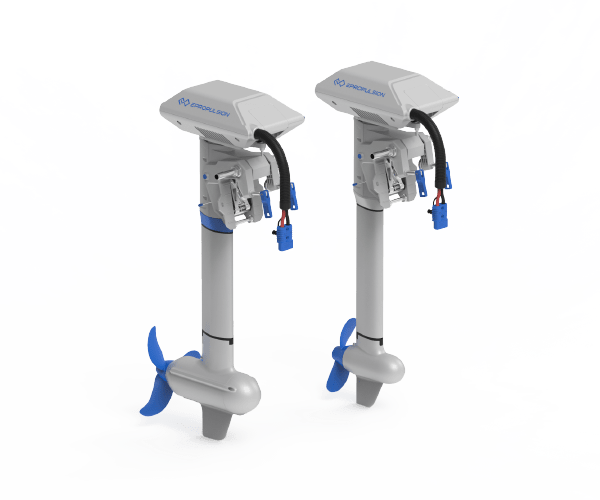
According to our test , the 6 HP electric motor Navy 3.0 can push the Catalina 25 sailboat (25 ft) at 6 mph (9.6 kph) top speed, while the Olga 33 sailboat (33 ft) can go at 7.5 mph (12 kph) with the 9.9 HP Navy 6.0 motor.
The Navy series electric sailboat motor also comes with regeneration features which can be recharged with hydrogeneration, wind turbine, and solar panel.
- Four controls to fit your sailboat installation and your boating style
- Accompany LiFePO4 batteries (need separate purchase) are more energy efficient
- Digital display offers real-time monitoring of the power and battery
- Magnetic kill switch and safety wristband keep you safe on the boat
- Electric start saves you trouble pulling the cord to start
Navy Series Electric Sailboat Motor Reviews:
“I have a Navy 3.0 with E80 on a Catalina 25 sailboat. It is working well. Currently I am using about 4% battery to go in/out of the marina by boat.” – Aaron Young
“Just finished my 8 weeks sailing journey in the Baltic Sea. The two Navy 3 outboards provide enough power for my 33ft catamaran. The 400W solar panels provided enough energy for engines and all other energy consumed on board with 2-6 persons. The two Navy Batteries provide power for engines and all other on-board electric devices. I never had to use shore power, so totally self-sufficient electric system.” – Martin Hildebrand
Recent Posts

ePropulsion Sustainably Mobilizes Hundreds of Sightseeing Bamboo Rafts on the Guilin Li River

Bass Boat Motors: The Only Guide You Need in 2024

ePropulsion’s Revolutionary eLite Electric Outboard Motor Wins Innovation Award in Miami
Join the discussion cancel reply.
Save my name, email, and website in this browser for the next time I comment.
Notify me via e-mail if anyone answers my comment.
This site uses cookies to personalize your experience and analyze site traffic. By clicking accept or continuing browsing the site, you are agreeing to our use of cookies. See our Privacy Policy here .
View the Serial Number
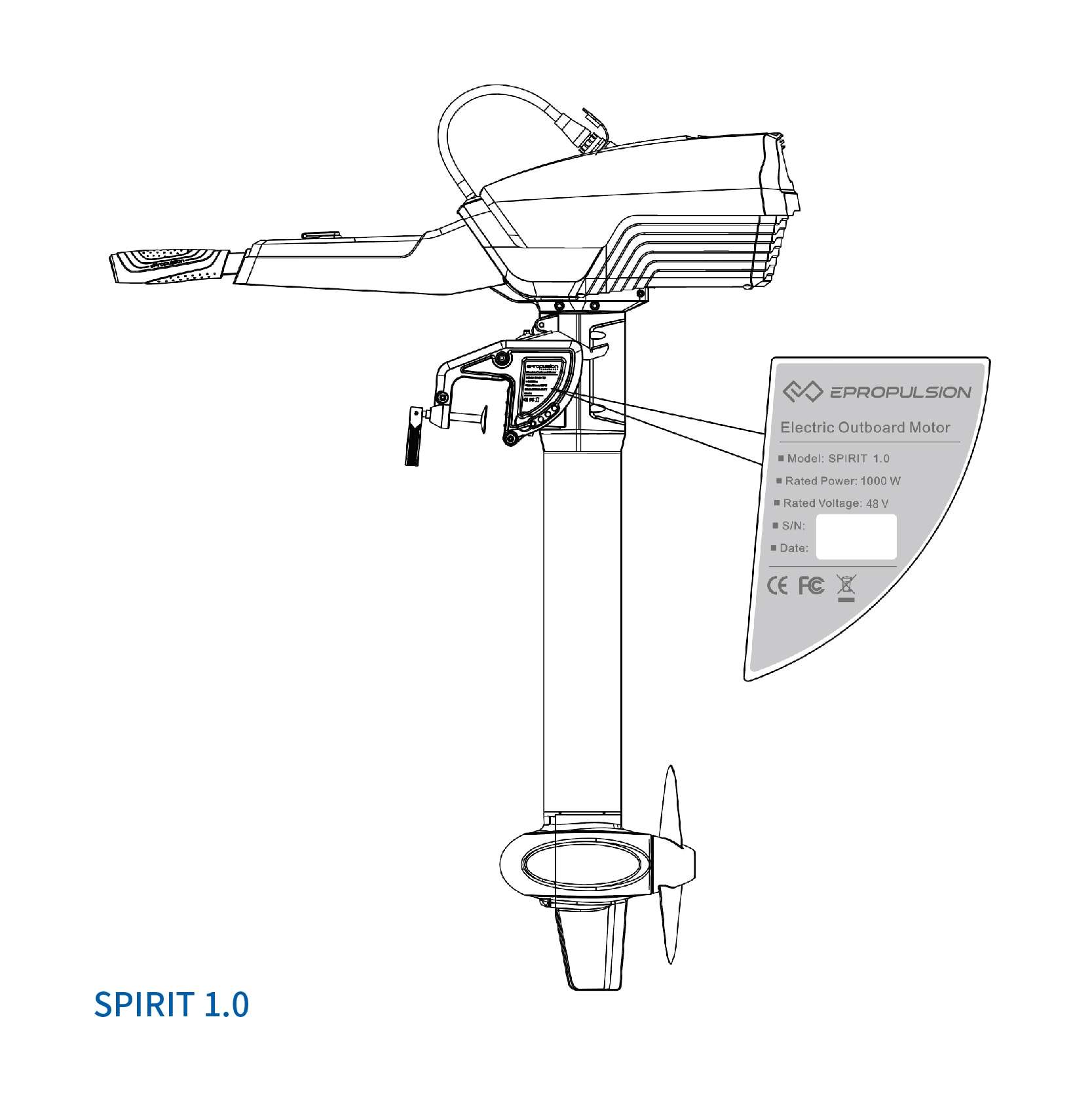
- AROUND THE SAILING WORLD
- BOAT OF THE YEAR
- Email Newsletters
- Best Marine Electronics & Technology
- America’s Cup
- St. Petersburg
- Caribbean Championship
- Boating Safety

Lightweight and Small Outboard Motors for Sailboats
- By Ed Sherman
- Updated: April 22, 2019
When you’re facing strong winds and you need to get somewhere fast, it’s time to break out a small outboard such as an aluminum genny. A dependable outboard that has enough horsepower to get you to the racecourse and back, yet is light enough not to be a drag on your race results, is invaluable. Most racing sailors don’t need as much horsepower as they might think.
An eight-horsepower outboard, for example, will push a 30-foot, 6,000-pound boat along at 6.5 knots. Anything bigger will weigh more than 90 pounds and isn’t suitable for lifting on and off the stern. Here’s our roundup of some of the best outboard motors for sailboats, and some help in deciphering what’s right for your boat.
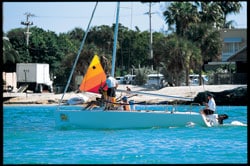
We focus our attention on engines available under nine different brand names. Two of the best-known names, Johnson and Evinrude, have dropped out of the small-engine end of the market as part of parent company Bombardier Corporation’s restructuring of these two companies. Currently they’re advertising the availability of six- and eight-horsepower four-stroke models in 2003. Another dropout in the mini-engine market is Suzuki. Their smallest two-stroke is a five-horsepower unit and in the four-stroke configuration, a 9.9 horsepower. Brand and corporate shuffling aside, of particular interest is whether the companies that are building nine horsepower- and-below engines have incorporated four-stroke technology into the lower horsepower range, since it’s now beginning to dominate the mid-sized and larger outboard engine market. The answer to that is yes, to a point.
Two or Four Stroke Outboards for Sailboats
Outboards are either two or four-stroke engines, and the four-strokes have definitely gained favor in recent years for several reasons: they’re quiet, they use much less fuel, and they run more cleanly. Since no oil is mixed with the fuel, the classic two-cycle smokescreen isn’t a factor. In a four-stroke, the piston reciprocates inside the cylinder four times for each power stroke (that is, each time fuel combusts). Rather than opening ports cut into the sides of the cylinder, intake and exhaust valves controlled by a camshaft allow a fuel/air mix to enter the combustion chamber with the suction created by the piston as it moves inward in its cylinder. Exhaust gases are forced out of the cylinder as the piston moves outward.
By carefully designing the camshaft, engineers minimize the amount of time that the intake and exhaust valves are both open, considerably reducing the amount of unburned fuel that exits with the exhaust stream. The end result? Fewer emissions and greater economy.
But they do have at least one distinct disadvantage for the racing sailor, and that’s weight. For example, four-stroke engines in the five-horsepower category are about 20 percent heavier than comparable two-stroke engines of the same horsepower. The good news, however, is that only amounts to between 10 and 15 pounds, depending upon the engine. Four-stroke engines cost more, also, but the improved technology may be well worth it.
If you’re totally weight and price conscious, you’ll want a two-stroke engine. But, if you think you can lose the weight elsewhere, a clean, quiet four-stroke without the hassle of mixing fuel could be the answer. In fact, Mercury/ Mariner’s newest six-horse four-stroke engines are actually 18 pounds lighter than their older two-stroke equivalents–a testament to the benefits of improved design and technology.
Environmental regulations are pushing manufacturers towards four-strokes as well. Four-strokes meet emission control standards, and US Environmental Protection Agency regulations mandate that new outboard and personal watercraft engines reduce engine hydrocarbon emissions by 75 percent by 2006. Environmentally conscious sailors should look for either a C.A.R.B. (California Air Resources Board) “very-low” or “ultra-low” designator, or a specification indicating 2006 EPA compliance.
How Much Horsepower Do You Need?
The amount of power you’ll need depends on several key factors. The first consideration is the weight of your boat. The second is the boat’s wetted surface. Full-keel boats not only weigh more but also have more surface area to push through the water. My rule of thumb here is to start with a two-horsepower engine for small centerboard and keelboats less than 1,000 pounds, and add one horsepower for every 1,000 pounds of displacement. For more exact, albeit complex formulae, I suggest The Propeller Handbook by Dave Gerr (McGraw-Hill 2001).
Compare your boat’s dimensions against what existing classes have found to work; for example, a Melges 24 at 1,650 pounds is typically rigged with a three-horsepower short-shaft engine, while a J/80 at 2,900 pounds can still squeak by with a long-shaft, three-horsepower engine. A 1,790 pound J/22, on the other hand, typically uses a four-horsepower long-shaft engine. On the larger end of boats using outboards, you’ll find the outboard version of the J/29, at 6,000 pounds, requires a 7.5-horsepower long-shaft engine.
If you are intending to do some cruising, or even long deliveries to regattas, an option that’s available on some engines is a high-thrust propeller. On larger boats, this option can save weight over a bigger engine and really make a difference when trying to punch through a strong tide or headwind. High-thrust props cost more and are less fuel efficient–but they can save weight and give you more power.
Once you’ve determined how big an engine you’ll need, the next step is to begin comparing features in the given horsepower range you’ve selected. There are nine manufacturers included in our roundup, but some of their brands are identical products with different labeling. In the smaller sizes, the Mercury and Mariner brands are identical. As for the Nissan and Tohatsu engines, Tohatsu builds them all. Yamaha, Suzuki, and Honda all offer competitive products as well, but they’re all independent brands.
What to Look For in Lightweight Outboard Motors
In the small engine sizes, specific features to look for can be reduced to several key items. For some, having an integral fuel tank will be important. The smallest engines have integral tanks that hold only a quart or two of fuel–good enough for an hour or two of operation. No manufacturer lists fuel consumption because the size boat the engine is pushing and the wind and wave conditions vary widely. Compare the size of the tanks, and whether you can attach a remote tank for longer trips. The extra weight and space of a separate fuel tank will be a burden on smaller ultra-light boats.
The availability of long- and short-shaft versions in the horsepower size you need is also important. Honda for example offers 20 and 25-inch transom height (long or short shaft) right down to their smallest BF2 (two-horsepower) model. Mercury and Mariner only offer a 15-inch short-shaft version on their 3.3- and 2.5-horsepower engines. Shaft length is measured from the top of the bracket to the tip of the shaft–make sure your shaft is long enough to position the propeller and cooling water intake deep enough below the waterline to avoid cavitation when the boat pitches through waves.
Other specifications that are worth comparing are whether the engine is equipped with a simple forward and neutral gearshift or if the unit has a full functioning forward-neutral-reverse gear unit. If you’re going to be doing long deliveries to regattas, or in the larger sizes for a racer/cruiser configuration, consider whether or not a charging system is part of the engine package, and if so, it’s output. Will it be adequate to keep your battery recharged and power things like a tiller pilot and running lights? Also, on the larger engines check to see if electric starting is available, or offered as a standard feature. Having it can be the difference between pain and pleasure.
If you are racing in a strict one-design group, check any class rules that apply to outboard engines. Issues related to brackets, storage of the engine and/or alternative weight might be issues, so be sure to check with your class before making any final decision.
Ed Sherman is the author of Outboard Engines, Maintenance, Troubleshooting and Repair, International Marine/McGraw Hill and a contributing editor to Sailing World.
- More: Accessories , clothing , Sailing Gear
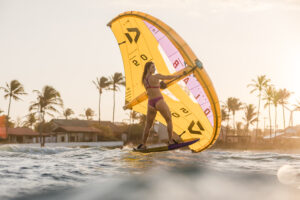
Wingfoiling Gear: A Beginner’s Guide
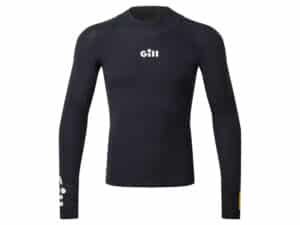
Suiting Up with Gill’s ZenTherm 2.0
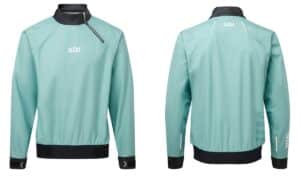
Gill Verso Lite Smock Keeps it Simple
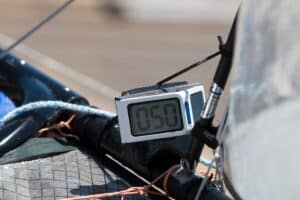
A Better Electronic Compass

Brauer Sails into Hearts, Minds and History

Anticipation and Temptation

America’s Offshore Couple

Jobson All-Star Juniors 2024: The Fast Generation

- Digital Edition
- Customer Service
- Privacy Policy
- Cruising World
- Sailing World
- Salt Water Sportsman
- Sport Fishing
- Wakeboarding
PowerFlow Marine
Experience the Power of Clean and Sustainable Propulsion
Upgrade your sailboat today and start enjoying the benefits of electric power on the water!
Electric Motors for Boats
Powerful Performance, Quiet operation, & Easy Installation

B15 (Liquid Cooled)
What our customers have to say about us.

Absolutely wonderful!
Error voluptate adipisci. Quas a delectus optio ut. Non consequatur voluptatem quia rerum cum similique enim.
Jack Nitzsche
Investor Group Coordinator
Electric Power Calculator
Simulate the performance of your vessel under electric propulsion

Don’t Miss Out
Get a free electrification report.
Our complimentary electrification report showcases the seamless integration of our electric motor system into your boat and outlines its impressive performance capabilities.
Passport 42
22kw direct-drive experience.
Sonya & Jack, a couple living on a boat in Mexico transform their Passport 42, Gemini into a fully electric vessel with the Powerflow Marine D22.
Frequently Asked Questions
- Quiet and vibration-free operation
- No exhaust fumes or fuel smell
- Seamless shifting between forwards and reverse
- Having only one moving part significantly reduces potential failure points compared to a diesel engine.
- Zero greenhouse emissions
- No pollution released into your local waterways
- Doesn’t scare away your local wildlife
- Option to be 100% renewable with solar and wind generation
- No more fuel and oil getting all over you and into your bilge
- No more need to carry combustible fuels on board
- Eliminate fuel costs
- Higher energy efficiency
- Charge from solar and wind
- Reduced maintenance cost
- Replacement components are relatively cheap
While sailing, our motor systems can harness wind power to recharge your batteries. Our display enables you to optimize energy capture by adjusting the braking level in real-time to match the sailing conditions. The amount of regeneration depends on various factors, with the propeller size being the primary determinant.
The motor size required for your boat depends on several factors, primarily the vessel’s size, weight, and operating conditions (such as currents, open sea, tides). User preference is also a consideration. As a rule of thumb, for displacement vessels, 1kW of electric power can replace approximately 3HP of diesel power. This may seem contradictory, but diesel motors are typically oversized to make up for their inefficiency and limited power delivery.
To assist you in motor sizing, we have developed an electric power calculator to simulate your vessel’s performance. Additionally, we provide a complimentary electrification report outlining the performance capabilities for your specific boat.
We have engineered our motor with retrofitting sailboats in mind, prioritizing ease of installation without compromising on durability or performance. Our free electrification report includes a 3D model illustrating how our motor system fits within the existing footprint of your diesel motor. We provide custom mounting brackets and shaft lengths to ensure a seamless installation.
Electric motors possess comparable power to diesel motors, while offering additional features that make them highly suitable for marine propulsion. They exhibit greater efficiency, typically 2 to 3 times more efficient than diesel motors, enabling an electric motor with one-third the size and weight to match the power output of a diesel motor. Moreover, electric motors can deliver torque across a broader range of speeds and provide full torque from 0 RPM.
Electric motors offer the advantage of seamless bidirectional operation, eliminating the need for a traditional gearbox with separate forward and reverse gears. While certain applications may still benefit from a gearbox, it would only require a single gear, effectively eliminating the inconvenient clunk often experienced when shifting between forward and reverse.
Customer Projects
July 9, 2023, june 15, 2023.
The Dory Shop
Lunenburg, Nova Scotia, Canada | (902) 640-3005 | [email protected]
- Outfitting /
- Motorization
- Sailing Rigs
- Accessories
- Dory Merchandise

Traditional tip-up motor well
The traditional arrangement for adding power by outboard, the tip-up well is a long rectangular box fitted to the bottom of the boat, on which a small horsepower outboard can be hung and into which the prop and shaft can be swung up, safely out of the way when you wish to beach or trailer your boat.

Custom-built upright motor well
Since cutting a hole in the bottom of a boat does reduce a dory's freeboard - that is, the boat above the waterline - and installing the old-fashioned tip- up well also takes up a certain amount of interior space, there are those who prefer to keep the footprint of their well as small as possible. For these folks, we offer what we call an upright well, custom-built to accommodate the specifications of their particular outboard. The one downside is that in this arrangement, the motor must be physically lifted or otherwise raised out of the well for the boat to be beached or trailered; it can't be tipped up. We’re happy to discuss which option suits you best.
Inboard engines
The most authentic way to power our larger dories is via an inboard engine. While the cost and availability of outboards has made this less common in recent years, we remain keen to assist clients with this arrangement in mind. Whether you're thinking of an authentic gas engine like the Make and Breaks manufactured under the brand names Atlantic and Acadia here in Nova Scotia, a nice little diesel unit or one of the new electric motors, we're happy to assist.
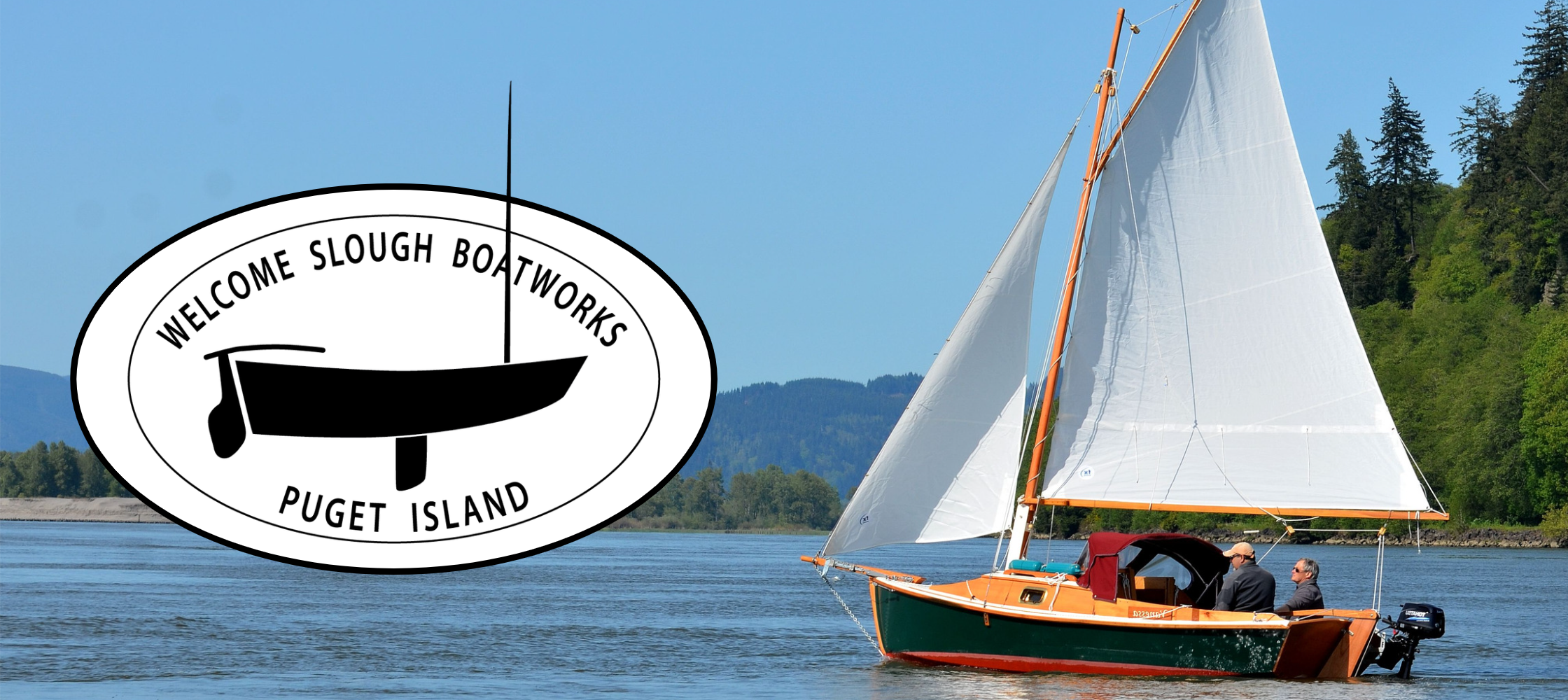

20′ Banks Fishing Dory, USCG – Outboard Motor Well
Today I nearly worked all day calculating the outboard motor well. What is left to design and build is the removable tunnel baffle that will start at the bottom “V” of the motor well and come up to the bottom of the rear notch. This will force the prop wash to propel the boat naturally. The large notch cutouts on each side of the well will allow the motor to swivel to the port and starboard so the boat can be maneuvered with ease.
Sailing Advantage! Electric Sailboat Outboard Motors

In 1993, I purchased a 1979 Chrysler 22, a heavy 22-foot sloop design with 3000-lb displacement. It had a 6hp Sailor model, long shaft, 2-stroke outboard motor. I usually spent twenty minutes or more trying to start the motor and keep it running. It had to be "warmed up" before leaving the dock or it would die 20 feet out! It always seemed to quit running at the most inopportune times. Since it was an old 2-stroke, it was a smoky, smelly, air and water polluter. Not at all consistent with my vision of sailing: smooth, quiet, and enjoying the fresh air and sunshine! Then, in 2008, I replaced that 2-stroke gas motor with an electric, 24-volt Minn Kota Riptide Rt80/s trolling motor, rated at 80 pounds of thrust. I mounted the Minn Kota electric on the same outboard motor mount as used for the gas outboard. It was a simple switch and made it easy to raise and lower the new electric motor into the water, just as with the gas outboard. What a pleasure! Quiet and reliable, instant "on" and quick change from forward to reverse. No stalling and no warm-up necessary. No longer worried about the motor stopping or not starting, sailing that Chrysler 22 became the pleasure it was intended to be! I sail a different boat now and my Minn Kota Riptide Rt80/s works just as well with my Laguna Windrose 18 as it did with my Chrysler 22. NEWS!-- Our Laguna Windrose sailboat is for sale - Laguna Windrose - sales flyer
more pictures in the photo gallery ...
Is it right for you understand your goals.

With an Electric Motor How fast will my boat go?

Next page for MOTORS →

All About Electric Sailboat Motors: Efficiency & Performance
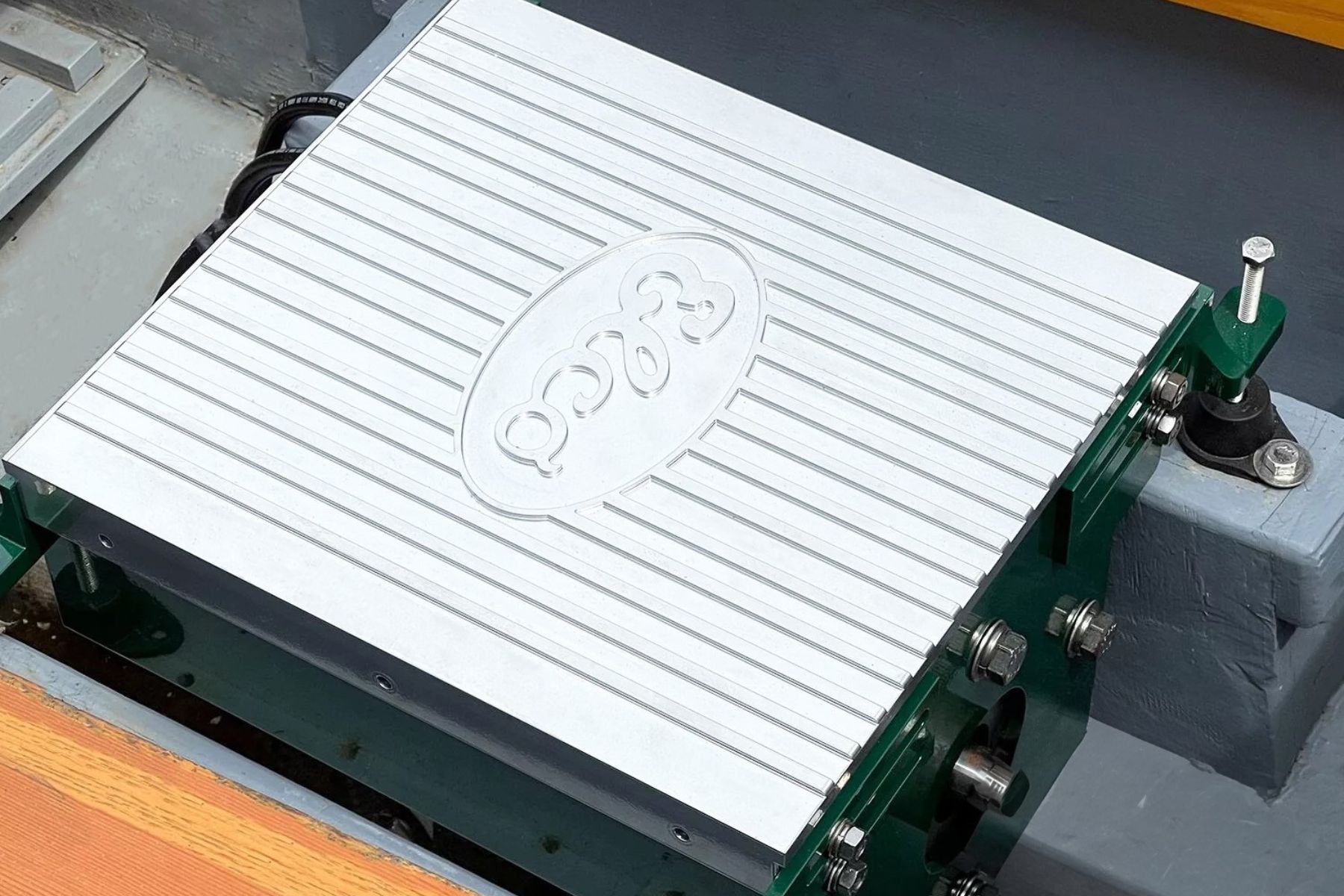
Exploring the Environmental Benefits of Electric Boat Motors
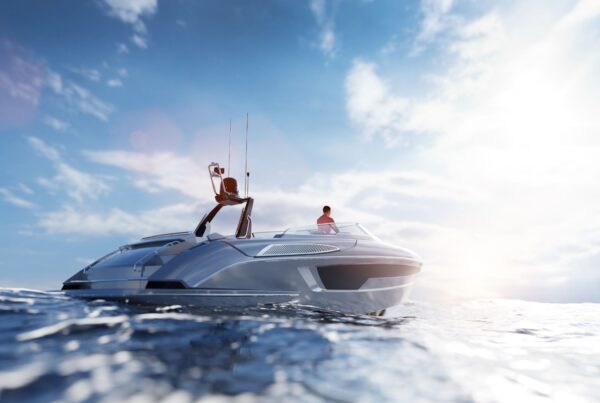
- Privacy Overview
- Strictly Necessary Cookies
This website uses cookies so that we can provide you with the best user experience possible. Cookie information is stored in your browser and performs functions such as recognising you when you return to our website and helping our team to understand which sections of the website you find most interesting and useful.
Strictly Necessary Cookie should be enabled at all times so that we can save your preferences for cookie settings.
If you disable this cookie, we will not be able to save your preferences. This means that every time you visit this website you will need to enable or disable cookies again.
Log in or Sign up
You are using an out of date browser. It may not display this or other websites correctly. You should upgrade or use an alternative browser .
building an outboard motor well for a 30-foot sailboat
Discussion in ' Outboards ' started by CBTerry , Jun 9, 2017 .
- outboard motor well
- sailboat outboard motor
CBTerry Better, is the enemy of good enough.
Hello! I have a 30 foot Pearson Wanderer and a 15 horsepower Johnson sailmaster which I am trying to get married. It is an extra long shaft and I just received a 10 inch diameter four blade 5 inch pitch prop to push it about with. The decision I'm having trouble with is whether or not to have a vertical slide, which would require the building of a bit of a box on the aft deck, or to have the motor tilt. Having the motor tilt would require slotting the transom as well as the bottom of the boat and the motor would be exposed and that could cause problems. The box I'm not too worried about building because I will probably be adding a mizzen mast to make her into a yawl. Getting the control cables to articulate the 30 inches or so might be problematic but I have a couple quite long cables so I think I can pull this off. I would love to hear opinions regarding the motor tilting or the motor traveling vertically (or anything else, such as dark matter, which I still think is a bit of a sketchy idea). Getting the motor to travel vertically I can easily have a bomb door for smooth, quiet sailing.
OXE Diesel Outboard Experiences?
Height placement of Mercury 200 outboard on 24’ tritoon
Small Outboard Fuel Pump ?
Oldest high thrust outboard
outboard for a strawler
Outboard Brake Specific Fuel Consumption Map
New 2-Stroke Outboard from BRP
Low hp xxl (30") shaft outboard.
Gas in fuel line to outboard
Replumbing an outboard for heat.
- No, create an account now.
- Yes, my password is:
- Forgot your password?

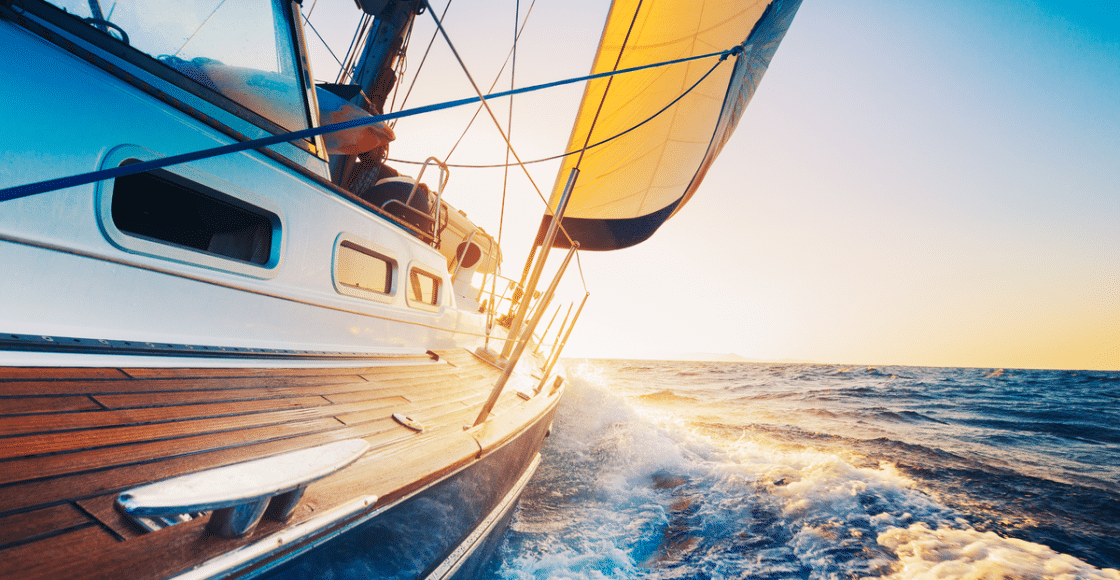
Do Sailboats Have Motors?

Table of Contents
Most sailboats over the length of 16 feet have some form of auxiliary power. That may be an electric motor or gas-powered outboard. But the larger a sailboat, the more need there is for an engine.
The purpose of a motor on most sailboats is for maneuvering when in the harbor or marina. Sailors also use a motor when loading their sailboat onto their trailers. Of course, all of the above can be done without a motor, but it takes a lot of skill. However, a powered boat sure is nice to have when you’re making a run for safe harbor or when the wind stalls.
What is a sailboat with a motor called?
Most modern sailboats have motors. The type of motor depends on the age of the boat, the size of the vessel, and its purpose. However, there is a class sailboat called a motorsailer . It has an engine that can move it along at speed without the sails, or only the sails can propel it.
Many older motorsailer designs don’t do very well at either task. Newer designs, however, range from a mere 26 feet to 100 feet or more, and sail and motor equally well, due to modern boat designs and engineering techniques.
Sailors tend to be purists, and although motors are necessary for safety, they want them to be as unobtrusive as possible. Even today’s motorsailers are on board with this philosophy. As we age, hanging over the rail retrieving a loose sail gets less and less exciting, and the appeal of a motor sailor becomes greater.
Do all sailboats have a motor?
No, because many real small sailboats don’t need one, and a paddle will suffice as auxiliary power. Prams, dinghies, small sailboats, and beach cats don’t generally need a motor. This is because they are primarily sailed from the beach. However, small sailboats can benefit from the use of today’s modern electric motors.
Unlike older electric boat motors that require a heavy battery for power, modern electric outboard motors have self-contained batteries. This fact makes using them a breeze. The problem with them is the battery doesn’t have enough juice to last more than a few hours.
That is okay if you are in a dinghy, but in a larger sailboat that may go out past the horizon, you want a motor that will get you back home.
What types of motors do sailboats have?
There are four distinct types of marine engines and thrusters, too.
1. Gas outboard engines
As already mentioned, gas outboards are used primarily for boats less than 30 feet in length. They are convenient because they cause no motor odor in the cabin , and you can replace them quickly if they fail. These motors range from three horsepower up to over 50 horsepower for some sailboats. Gas outboards have been used on sailboats for over 50 years, and they will continue to be used for years to come.
2. Diesel engines for sailboats
Diesel engines are the power of choice for sailboats . They are reliable, efficient, and relatively quiet. Diesel sailboat motors range from a tiny nine-horsepower unit, for smaller boats, up to about 125 horsepower, which is enough power for all but larger motorsailers and sailboats.
Until the 1970s, the most common inboard diesel for sailboats was Universal’s Atomic 4. However, since they closed their doors, several companies have worked to fill the marine engine niche. These companies include John Deer, Kubota, Yanmar, and Westerbeke, who still makes parts for the Atomic 4. All of them make marine diesel engines for small and large sailboats.
3. Electric motors for sailboats
Electric outboard motors have been mentioned for use on prams, dinghies, and other small craft. However, due to trial and error, electric motors have been designed to power sailboats larger than dinghies and trailer sailors. Like diesel motors, electric motors are placed in the lower section of the boat and connected to a shaft and propeller . Connected to a large bank of batteries that can be recharged with solar panels, a wind generator, or a hydro generator, an electric motor is used for maneuverability around the harbor and marina.
Using a purely electric motor for a sailboat has limitations due to the inability to store or generate enough power to motor for hours at a time. Due to this small storage capacity, they can only be used for a short time before they need to be recharged.
4. Hybrid electric power for sailboats
Combining the attributes of diesel power with the clean energy of electricity , hybrid-electric power plants, aka diesel-electric power, is the best of both worlds. With this type of power in your sailboat, power is almost free and endless. Note I said, virtually, because the diesel tank does need to be filled occasionally.
Hybrid electric power uses an electric motor to power your boat and a small diesel engine to charge the bank of batteries. When combined with solar panels and other methods of battery recharging, hybrid-electric power is becoming standard on new production sailboats and as conversions on older sailboats.
5. About those thrusters
The motor no one sees, bow thrusters are a great aid when docking or putting your boat on a trailer. Once only seen on sailboats over 50 feet in length, bow thrusters are a significant aid when docking and maneuvering around other craft in the harbor. They are now available for boats as small as 25 feet in length.
Types of sailboats
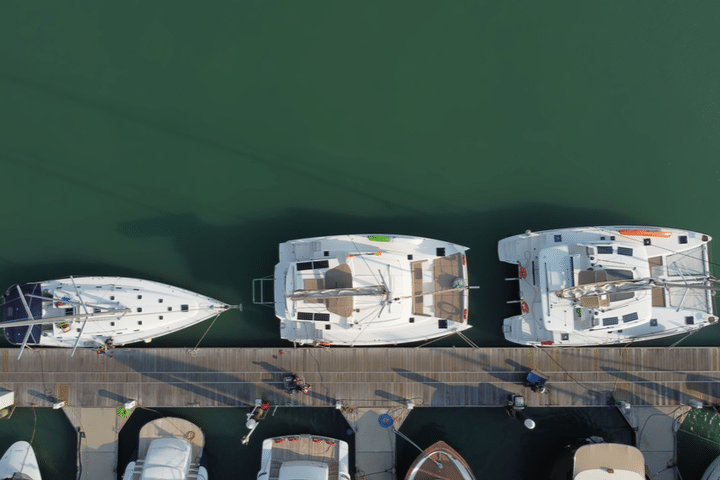
Motorsailers were mentioned above, but hull types have not been, and there are three main types of hulls for sailboats. They are the monohull , which means just what it says; the boat has one hull and usually just one motor. However, some large motorsailers often sport two engines.
Catamaran sailboats have two hulls, and many of those over 30 feet in length has two engines. Two engines are great for the redundancy of systems. Still, it is an added expense because it costs more to maintain two motors than one.
The next type of sailing vessel you will see in small and extremely large versions is the trimaran, which has three hulls. However, three hulls do not equate to three engines, and they generally have only one inboard motor for boats over 30 feet. Smaller trimarans use outboard motors for power or no power at all.
The cost of owning a sailboat
Small sailboats that can fit on a trailer and get hauled to the water have a low cost to own. In addition, general maintenance is not very expensive . Any care that you need to do is usually within the scope of sailboat owners with moderate skills with tools.
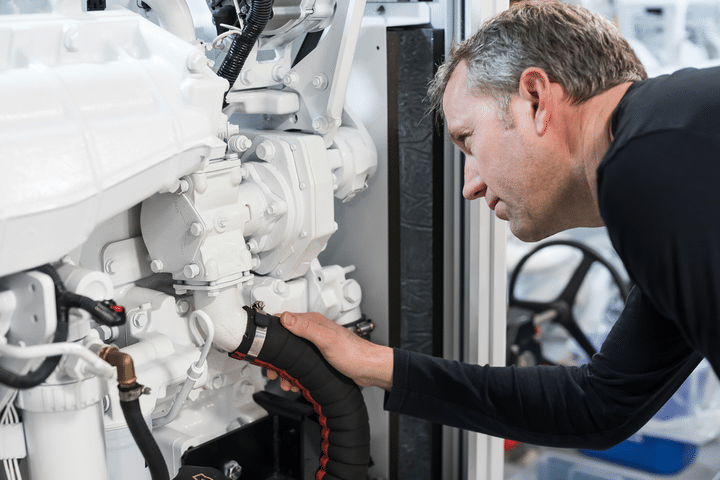
However, when you get into the realm of diesel engines, hybrid power systems, and bow thrusters, maintenance takes on a new dimension. Most boat owners can do the maintenance necessary to keep their engines running, such as oil changes, checking fluids, and filtering fuel .
However, when the time for servicing comes, a mechanic will be necessary. They run a minimum of $100 an hour unless you are lucky enough that you can call a friend.
Maintaining a sailboat is expensive – we can help
At Boatsetter, we work with sailors who rent their sailboats to people around the world. Our boat rental community allows you to rent only your boat, or you can join the party as captain of your ship as you impart your sailing knowledge to your paying guests. Renting your sailboat is one way to offset some of your annual costs with the added benefit of getting paid to be captain for the day.

Boatsetter empowers people to explore with confidence by showing them a world of possibility on the water. Rent a boat, list your boat, or become a Boatsetter captain today.
Browse by experience

Explore articles

Lake Keowee Fishing Guide

5 Best Beaches in Charleston, South Carolina to Get to by Boat
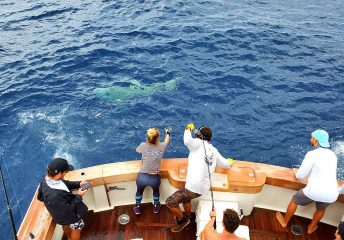
Fishing in Fort Lauderdale Guide

Activities on the Water for the Little Ones

Can You Put a Motor on a Sailboat? (The Answer Will Surprise You)

Sailboats have been around for centuries, and theyre still an incredibly popular way to traverse the open sea.
But what if youre looking for a more dynamic sailing experience? Can you put a motor on a sailboat? The answer might surprise you.
In this article, well explore the different types of motorized sailboats, the benefits of adding a motor to a sailboat, and the pros and cons of using a motor.
Well also discuss the installation process and maintenance of a motorized sailboat.
So if youre considering giving your sailboat a motor, read on!
Table of Contents
Short Answer
Yes, you can put a motor on a sailboat.
Depending on the size of the boat, this can be done with an outboard motor, an inboard motor, or an inboard/outboard motor.
Motors may be added for convenience or to provide an auxiliary power source in case of lack of wind.
The type and size of motor that can be used will depend on the size and type of sailboat .
What Is a Motorized Sailboat?
A motorized sailboat, also known as a motor sailor, is a sailboat that is equipped with an auxiliary motor.
This type of boat is becoming increasingly popular as more and more sailors look for the convenience and efficiency of a motorized vessel without sacrificing the traditional sailing experience.
Motorized sailboats can be either powered by an inboard or outboard motor, or even an electric motor.
Depending on the size and type of vessel, the motor may be used for propulsion, maneuvering, or both.
Inboard motors are typically more powerful and can be used to power the boat for longer distances.
Outboard motors are less powerful but are easier to install and maintain, and can be used for shorter trips and for maneuvering in tight spaces.
Electric motors are becoming increasingly popular due to their quiet operation and environmentally friendly nature.
Motorized sailboats can provide a great deal of convenience, from eliminating the need to raise and lower sails, to allowing for easier maneuvering and docking.
They also provide greater flexibility in terms of sailing destinations, as they can often cover longer distances in a shorter amount of time than traditional sailboats.
For those who are looking for a more leisurely experience, motorized sailboats can still provide the same sailing experience, albeit at a slower pace.
No matter the type of motor, motorized sailboats offer a great way to enhance the sailing experience.
They can make sailing more efficient and convenient, while still providing the traditional sailing experience.
With a variety of motor options available, its easy to find the best option for your boat and your sailing needs.
Benefits of Adding a Motor to a Sailboat

Adding a motor to a sailboat can be an incredibly beneficial upgrade for a variety of reasons.
It can make sailing easier, faster, and more efficient.
It can reduce the amount of time and effort required for maneuvering, and it can open up new sailing opportunities, such as longer voyages and exploring new areas.
It can also be used to help with docking and other maneuvers, which can be extremely helpful for beginners.
Additionally, a motor can provide a much-needed boost when the wind is light or nonexistent, which can save time and energy.
Finally, a motor can be a great safety feature, as it can be used to get out of potentially dangerous situations quickly and easily.
Types of Motors for Sailboats
When it comes to adding a motor to a sailboat, there are a variety of options available.
Traditional inboard engines are the most common motor choice for sailboats.
These motors are installed inside the hull, and are usually powered by gasoline or diesel fuel.
Inboard engines are powerful and reliable, and are great for larger sailboats that need to move quickly.
Outboard motors are also popular for sailboats, and are usually smaller and more portable than inboard engines.
Outboard motors are typically powered by gasoline, but there are also electric outboard motors available.
These motors are more environmentally friendly, and also quieter and easier to maintain.
Electric motors are also becoming increasingly popular for sailboats, as they are more efficient and require less maintenance.
Electric motors are usually powered by batteries, and can provide enough power for smaller sailboats to cruise at a comfortable speed.
Depending on the size and intended use of your sailboat, you can choose the best type of motor for your boat.
Choosing the Right Motor for Your Boat

When it comes to choosing the right motor for your sailboat, there are a few factors to consider.
First, you need to determine the type of motor that is best suited for your boat.
Traditional inboard engines are the most common choice, as they are powerful and can be used for long voyages.
Outboard motors are a great option for smaller boats, as they are lightweight and easy to install.
If you are looking to reduce your carbon footprint, electric motors are an environmentally friendly choice.
Once you have chosen the type of motor, you need to determine the size of the motor you need.
If you are planning on doing long voyages or sailing in the open sea, you’ll need a larger motor that can provide enough power for the journey.
If you are mainly sailing in shallower waters or shorter distances, a smaller motor should be sufficient.
You’ll also want to consider the noise level when selecting a motor, as some motors can be quite loud and may disturb other boaters.
Finally, you’ll need to consider the cost of the motor.
Inboard motors can be quite pricey, but they are more powerful and reliable.
Outboard motors are more affordable, but they require more maintenance.
Electric motors are often the most cost-effective, but you’ll need to make sure you have the necessary charging equipment.
By taking all of these factors into consideration, you can choose the best motor for your sailboat.
With the right motor, you’ll be able to enjoy sailing more efficiently and with greater comfort.
Pros and Cons of Using a Motor
Adding a motor to a sailboat can be a great way to make sailing easier, faster, and more efficient.
It can reduce the time and effort spent on maneuvering and can open up new sailing opportunities, such as longer voyages and exploring new areas.
It can also be used to help with docking and other maneuvers.
But, as with any major change to a boat, there are pros and cons of using a motor.
The major advantage of using a motor on a sailboat is that it can reduce the amount of time and effort spent on maneuvering and allow for longer voyages.
This is especially useful in areas with strong winds, as it can help you navigate more easily.
Motors also make it easier to dock, as you dont have to worry about dealing with the wind and waves.
Additionally, motors can provide a steady source of power for onboard electronics and other equipment, even when youre not sailing.
However, there are a few drawbacks to using a motor on a sailboat.
The biggest downside is the cost, as motors can be expensive to purchase and maintain.
Additionally, motors require fuel, which can be costly and environmentally unfriendly.
Additionally, using a motor can be noisy and can cause vibrations that can be uncomfortable to passengers.
Finally, motors can be difficult to maintain and can require frequent repairs.
In conclusion, adding a motor to a sailboat can be a great way to make sailing easier, faster, and more efficient.
However, it is important to consider the pros and cons before making the decision to install a motor.
If you decide to go ahead with it, make sure to research the best motor for your specific boat and budget.
Installation Process

Adding a motor to a sailboat is a relatively straightforward process.
Depending on the type of motor you are looking to install, the process can vary from relatively simple to more complex.
Generally, the motor will need to be securely mounted to the stern of the sailboat, and all the necessary hardware and wiring will have to be connected.
For an inboard motor, the motor will need to be connected to the fuel tank, and the exhaust system will also have to be installed.
For an outboard motor, the motor will need to be securely mounted to the transom of the boat, and the fuel line and electrical connections will need to be connected.
With an electric motor, the motor will need to be mounted to the stern and the wiring connected.
In addition to the physical installation of the motor, it is also important to ensure that the motor is properly serviced and maintained.
This includes checking the oil and fuel levels, ensuring the motor is properly lubricated, and adjusting the engine speed.
Regular maintenance and service will ensure that your motor is running optimally and will help to prevent any potential problems.
Finally, it is important to remember that safety should always be the top priority when operating a motorized sailboat.
It is important to have a good understanding of the local laws and regulations regarding motorized boats, and to always wear a life jacket when operating the boat.
It is also important to be aware of the potential dangers associated with using a motor on a sailboat, such as the risk of capsizing or collision with other boats.
With proper safety precautions, a motorized sailboat can be an enjoyable and safe way to explore the water.
Maintenance
When considering adding a motor to a sailboat, it is important to consider the maintenance required.
Any motorized boat will require regular maintenance and inspections, but sailboats with motors will need extra attention due to the additional parts and components involved.
Outboard motors should be checked for corrosion and wear, and the fuel and oil should be changed regularly.
Inboard motors should also be inspected for wear, and the fuel and oil should be changed regularly.
Electric motors should be checked for corrosion and wear, and the battery should be recharged as needed.
Additionally, the propeller should be regularly checked and cleaned to ensure optimal performance.
Final Thoughts
Adding a motor to a sailboat is a great way to make sailing easier, faster, and more efficient.
There are a variety of motor options available, from traditional inboard engines to outboard motors, and electric motors.
Depending on your sailing needs and preferences, you can choose the best option for your boat.
Keep in mind that installation and maintenance of the motor should be considered when making your decision.
With the right motor, you can unlock new opportunities and take your sailing to the next level.
James Frami
At the age of 15, he and four other friends from his neighborhood constructed their first boat. He has been sailing for almost 30 years and has a wealth of knowledge that he wants to share with others.
Recent Posts
Does Your Boat License Expire? Here's What You Need to Know
Are you a boat owner looking to stay up-to-date on your license requirements? If so, youve come to the right place! In this article, well cover everything you need to know about boat license...
How to Put Skins on Your Boat in Sea of Thieves? (Complete Guide)
There is a unique sense of pride and accomplishment when you show off a boat you customized to your exact specifications. With Sea of Thieves, you can customize your boat to make it look like your...
Watch CBS News
What we know about the condition of Baltimore's Francis Scott Key Bridge and how this sort of collapse could happen
By Caitlin O'Kane
Updated on: March 26, 2024 / 7:58 PM EDT / CBS News
Baltimore's Francis Scott Key Bridge collapsed early Tuesday morning after one of its columns was hit by a large container ship. Video of the bridge shows it buckle and crash into the river below after the Dali, a massive 948-foot cargo ship, strikes it, sending vehicles and people into the river below. Six people were missing, and after a daylong search and rescue effort, the U.S. Coast Guard said Tuesday evening it was shifting to a recovery mission.
Here's what we know about the condition of the bridge and how this sort of collapse could happen.
During its latest federal inspection, the Key Bridge scored a six out of nine, which is considered "fair," a condition it had been labeled since 2008, CBS Baltimore reported .
The bridge passed inspection in May 2022, but there was concern with one of its columns. The reinforced concrete column was downgraded from a health index, or condition rating, of 77.8 to 65.9. It is not known whether the column of concern was the same one that was struck on Tuesday morning.
Ben Schafer, professor of civil and systems engineering at Johns Hopkins University, told CBS News that most bridges in the U.S. fall in this "fair" range, which is "not what we would want or suspect" as a society. But, he said, the massive ship — not the condition of the Key Bridge — is likely to blame for its collapse.
"Like others, I've watched the video a bunch of times and have gone frame by frame and worked up a few different hypothesis in my mind, but I see little evidence for anything other than: the boat strike took a bridge with two supports and took away one of them and then it fell in the water," Schafer told CBS News. "I mean, doesn't seem to be super more complicated than that."
Transportation Secretary Pete Buttigieg expressed a similar view at a briefing Tuesday afternoon. "This is a unique circumstance. I do not know of a bridge that has been constructed to withstand a direct impact from a vessel of this size. Anytime anything happens to any bridge, we as a country take that and learn from it," Buttigieg said.
Many bridges, whether a suspension bridge or an arched bridge, require two supports under the portion of bridge that goes over water, Schafer said. "This is the minimum number to cross over," he said.
"The container ship was as wide as it was as tall," Schafer said, adding that it was of similar scale to the bridge. "So the mass that's associated with that container ship creates an amount of energy that a small concrete pier isn't going to sustain. That's an accident that we can't allow to happen and expect the bridges to stay up."
Schafer said in the late 1800s, the Quebec Bridge, which had a similar design to Baltimore's Key Bridge, collapsed, which taught engineers many lessons about truss bridges. But by the 1970s when the Key Bridge was built, the design used was modern and sufficient.
Schafer said there is a lesson to be learned here, but it's likely not that changes to a bridge's design would help prevent an accident like this. He said the way shipping traffic is managed, or the size of container ships — which have likely increased since the 1970s when the bride was built — should be considered when trying to understand the risk of these types of accidents.
Robert Sumwalt, former chairman of the National Transportation Safety Board, told CBS News that the video of the accident holds some clues about what could have happened. The lights of the ship flashes off and on, which would indicated an electrical power failure, he said. Authorities confirmed the ship did lose power before the crash.
Black smoke is also seen coming out of the ship, which Sumwalt said likely means "ship's crew is trying to increase the RPMs across the propeller to increase the steering capability of it."
All of the crew members on the Dali were accounted for and there were no reports of any injuries among the crew. Sumwalt also said the ship's audio recording device likely captured conversations happening on the ship as well as other data like the angle of the rudder. "There will be a lot of information to help piece this back together," he said.
The four-lane Key Bridge is 1.6 miles long and was used by some 31,000 people a day, according CBS News Baltimore. Sumwalt said only two other tunnels cross the Patapsco River, so without the bridge, access will be limited.
A construction crew was filling potholes on the bridge at the time of the accident. Two workers were rescued from the water but six remained unaccounted for Tuesday night, officials said.
- Bridge Collapse

Caitlin O'Kane is a New York City journalist who works on the CBS News social media team as a senior manager of content and production. She writes about a variety of topics and produces "The Uplift," CBS News' streaming show that focuses on good news.
More from CBS News

Pete Buttigieg says "we don't fully know" conditions for Baltimore bridge repair

Second temporary passage clears way for more smaller vessels past Key Bridge collapse site

Transcript: Baltimore Mayor Brandon Scott on "Face the Nation," March 31, 2024

Transcript: Transportation Secretary Pete Buttigieg on "Face the Nation," March 31, 2024
Automotive Data since 1903
Automotive aftermarket charitable foundation launches 65th anniversary fundraising initiative.
AACF is calling upon automotive aftermarket industry professionals, as well as compassionate individuals eager to lend a helping hand
Sacramento, Calif.— The Automotive Aftermarket Charitable Foundation (AACF) , a 501c3 supporting people in the automotive aftermarket industry and their families during the hardest moments of their lives, has announced the launch of its 65th-anniversary fundraising initiative.
Running through July 1, the campaign aims to raise $65,000 through 1,000 donations of $65 each. This impactful effort highlights the industry’s commitment to taking care of its own.

For over six decades, AACF has been a beacon of hope for those in need of assistance in the automotive aftermarket community. From sudden illness and death to natural disasters, the foundation has provided vital assistance to industry professionals and their families during their darkest hours. As AACF celebrates its 65th year of service, it remains steadfast in its mission to provide financial support and resources to those in the automotive aftermarket industry in need.
In honor of this milestone, AACF is calling upon automotive aftermarket industry professionals, as well as compassionate individuals eager to lend a helping hand, to join forces in raising $65,000. By making a symbolic donation of $65, supporters can contribute to a fund that offer vital assistance during a time of greatest need.
“Over the past 65 years, AACF has remained unwavering in its commitment to supporting members of the automotive aftermarket community during their most challenging moments,” said Joel Ayres, AACF Executive Director. “As we embark on this historic fundraising initiative, we are inspired by the generosity and compassion of our supporters. Together, we can make a profound difference in the lives of those facing adversity, demonstrating the industry’s unwavering dedication to taking care of its own.”
To participate in the 65th-anniversary fundraising initiative and help AACF reach its goal of $65,000, individuals are encouraged to click on this link . Every $65 donation brings us one step closer to providing vital assistance to those in need. For more information or to get involved, contact Joel Ayres at [email protected] .
No results found.
New vehicle sales in the U.S. rose nearly 5% in 2024 as buyers defied high interest rates, but EV sales growth slowed

New vehicle sales in the U.S. rose nearly 5% from January through March, as buyers stayed in the market despite high interest rates. But electric vehicle sales growth slowed during the first three months of the year, with mainstream buyers wary of limited range and a lack of charging stations .
Automakers, most of which reported U.S. sales numbers Tuesday, sold nearly 3.8 million vehicles in the first quarter versus a year ago, for an annual rate of 15.4 million in sales.
With inventory on dealer lots growing toward pre-pandemic levels, auto companies were forced to reduce prices. J.D. Power said the average sales price in March was $44,186, down 3.6% from a year ago and the largest recorded decline for the month of March.
The company said automaker discounts in March were two-thirds higher than a year ago, around $2,800. That includes increased availability of lease deals. J.D. Power expected leases to account for almost a quarter of retail sales last month, up from 19.6% in March of last year.
Sales of electric vehicles grew only 2.7% to just over 268,000 during the quarter, far below the 47% growth that fueled record sales and a 7.6% market share last year. The slowdown, led by Tesla, confirms automakers’ fears that they moved too quickly to pursue EV buyers. The EV share of total U.S. sales fell to 7.1% in the first quarter.
Nearly all of the early adopters and people concerned about internal-combustion engines’ impact on the planet have bought electric vehicles, and now automakers are facing more skeptical mainstream buyers, Edmunds Director of Insights Ivan Drury said.
“That’s where all of those headwinds come in that we’ve seen in survey data,” Drury said. “Those real-world concerns about charging infrastructure, battery life, insurance costs.”
Cox Automotive Chief Economist Jonathan Smoke cautioned it appears the industry has already hit its spring sales peak as buyers expect the Federal Reserve to cut interest rates later in the year.
“Interest rates are still near 24-year highs, and consumers just don’t have the urgency to buy, with the expectation that rates will be lower later this year,” he wrote in a market report. Automobile interest rates still are averaging around 7% per year.
Drury said vehicles that are more affordable are selling faster than more expensive ones. Sales of many large and expensive SUVs fell during the quarter as companies faced more frugal buyers.
“Small sells, whether it be size or the sales price,” Drury said.
For example, General Motors’ Chevrolet brand sold 37,588 Trax small SUVs in the quarter, more than a fivefold increase from a year ago. By itself, the Trax, which starts around $21,500, outsold the entire Cadillac brand.
Most automakers reported strong year-over-year sales increases from January through March, but General Motors , Stellantis , Kia and Tesla all reported declines.
GM, the top-selling automaker in the U.S., reported that sales were down 1.5% for the quarter, while Stellantis sales were off nearly 10%. Kia sales were down 2.5%. All three companies reported strong first-quarter sales a year ago.
Toyota reported a large sales increase, 20%, for the quarter, and said combined sales of its hybrids and lone electric vehicle rose 36%. Honda said its sales increased 17%, while Nissan and Subaru both posted 7% increases. Hyundai reported an increase of just 0.2%.
Tesla global sales were off nearly 9%, which the company blamed on factory changes to build an updated Model 3, shipping delays in the Red Sea and an attack that knocked out power to its factory in Germany . Motorintelligence.com estimated that Tesla’s U.S. sales were down more than 13% in the first quarter.
Latest in Finance
- 0 minutes ago

Baby boomers are selling their homes and millennials are buying—it’s a ‘generational tug of war,’ a top housing economist says

Johnson & Johnson CIO says employee upskilling is key to transforming health care

Elon Musk says he would ‘definitely’ buy Disney stock if investors elect Nelson Peltz to the board

Tiger closed its 16th fund at $2.2 billion, falling short of its $6 billion target.

90% of homebuyers have historically opted to work with a real estate agent or broker. Here’s why that’s unlikely to change, according to the National Association of Realtors

Adobe’s CFO on using AI to hit a $21.5 billion revenue target and stand out among peers including Canva
Most popular.

Singaporean firm whose ship took down the Baltimore bridge just cited an 1851 maritime law to cap liability at $44 million

Hyundai and Kia recalled 3.4m vehicles, warning to park them outdoors because they risked catching fire. 6 months later, most are still on the road, unrepaired

‘Cicada-geddon’ will hit America for first time since 1803, expert says: ‘Trillions of these amazing living organisms [coming] out of the Earth’

The ‘growing crisis of the young American male’ could send home prices falling for years or even decades, says the ‘Oracle of Wall Street’

America will be left with ‘severe, irreversible scars’ if national debt goes unchecked. Now, a blockbuster report warns the bill is higher than believed, hitting $141T by 2054

Oregon just officially changed its mind on decriminalizing drugs
Six presumed dead after cargo ship crash levels Baltimore bridge
BALTIMORE — A major Baltimore bridge collapsed like a house of cards early Tuesday after it was struck by a container ship, sending six people to their deaths in the dark waters below, and closing one of the country’s busiest ports.
By nightfall, the desperate search for six people who were working on the bridge and vanished when it fell apart had become a grim search for bodies.
“We do not believe that we’re going to find any of these individuals still alive,” Coast Guard Rear Admiral Shannon N. Gilreath said.
Jeffrey Pritzker, executive vice president of Brawner Builders, said earlier that one of his workers had survived. He did not release their names.
Up until then, Maryland Gov. Wes Moore had held out hope that the missing people might be found even as law enforcement warned that the frigid water and the fact that there had been no sign of them since 1:30 a.m. when the ship struck Francis Scott Key Bridge.
Moore expressed heartbreak after officials suspended the search for survivors.
"Our heart goes out to the families," he said. "I can’t imagine how painful today has been for these families, how painful these hours have been have been for these families."
It was a crushing blow to the loved ones of the missing men, who had waited for hours at a Royal Farms convenience store near the entrance of the bridge for word of their fate.
Follow live updates on the Baltimore bridge collapse
The tragic chain of events began early Tuesday when the cargo ship Dali notified authorities that it had lost power and issued a mayday moments before the 984-foot vessel slammed into a bridge support at a speed of 8 knots, which is about 9 mph.
Moore declared a state of emergency while rescue crews using sonar detected at least five vehicles in the frigid 50-foot-deep water: three passenger cars, a cement truck and another vehicle of some kind. Authorities do not believe anyone was inside the vehicles.
Investigators quickly concluded that it was an accident and not an act of terrorism.
Ship was involved in another collision
Earlier, two people were rescued from the water, Baltimore Fire Chief James Wallace said. One was in good condition and refused treatment, he said. The other was seriously injured and was being treated in a trauma center.
Moore said other drivers might have been in the water had it not been for those who, upon hearing the mayday, blocked off the bridge and kept other vehicles from crossing.
“These people are heroes,” Moore said. “They saved lives.”
Nearly eight years ago, the Dali was involved in an accident. In July 2016, it struck a quay at the Port of Antwerp-Bruges in Belgium, damaging the quay.
The nautical commission investigated the accident, but the details of the inquiry were not immediately clear Tuesday.
The Dali is operated and managed by Synergy Group. In a statement, the company said that two port pilots were at the helm during Tuesday's crash and that all 22 crew members onboard were accounted for.
The Dali was chartered by the Danish shipping giant Maersk, which said it would have no choice but to send its ships to other nearby ports with the Port of Baltimore closed.
The bridge, which is about a mile and a half long and carries Interstate 695 over the Patapsco River southeast of Baltimore, was "fully up to code," Moore said.
National Transportation Safety Board Chairwoman Jennifer Homendy said that her agency will lead the investigation and that a data recorder on the ship could provide more information.
"But right now we're focusing on the people, on the families," she said. "The rest can wait."
President Joe Biden vowed to rebuild the bridge and send federal funds.
"This is going to take some time," the president warned. "The people of Baltimore can count on us though to stick with them, at every step of the way, till the port is reopened and the bridge is rebuilt."
Speaking in Baltimore, Transportation Secretary Pete Buttigieg echoed the president's promise.
"This is no ordinary bridge," he said. "This is one of the cathedrals of American infrastructure."
But Buttigieg warned that replacing the bridge and reopening the port will take time and money and that it could affect supply chains.
The Port of Baltimore, the 11th largest in the U.S., is the busiest port for car imports and exports, handling more than 750,000 vehicles in 2023 alone, according to data from the Maryland Port Administration.
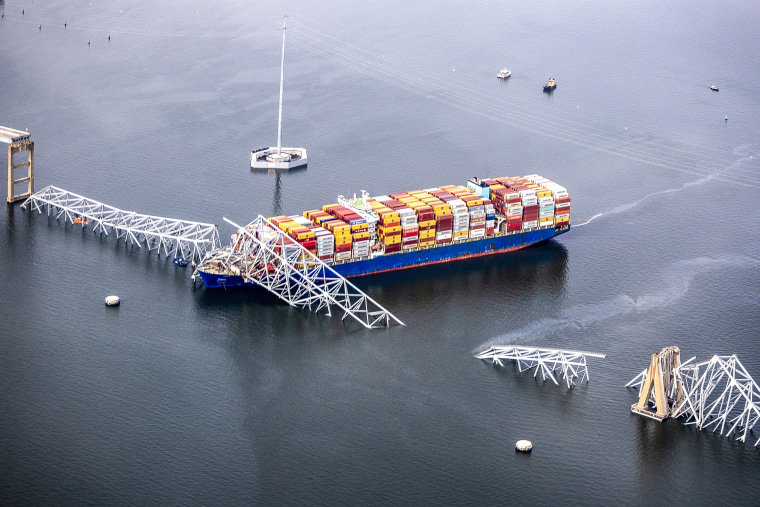
Writer David Simon, a champion of Baltimore who set his TV crime drama "The Wire" on the streets of the city he once covered as a reporter, warned online that the people who will suffer the most are those whose livelihoods depend on the port.
"Thinking first of the people on the bridge," Simon posted on X . "But the mind wanders to a port city strangling. All the people who rely on ships in and out."
Timeline of crash
Dramatic video captured the moment at 1:28 a.m. Tuesday when the Dali struck a support and sent the bridge tumbling into the water. A livestream showed cars and trucks on the bridge just before the strike. The ship did not sink, and its lights remained on.
Investigators said in a timeline that the Dali's lights suddenly shut off four minutes earlier before they came back on and that then, at 1:25 a.m. dark black smoke began billowing from the ship's chimney.
A minute later, at 1:26 a.m., the ship appeared to turn. And in the minutes before it slammed into the support, the lights flickered again.
Maryland Transportation Secretary Paul Wiedefeld said the workers on the bridge were repairing concrete ducts when the ship crashed into the structure.
At least seven workers were pouring concrete to fix potholes on the roadway on the bridge directly above where the ship hit, said James Krutzfeldt, a foreman.
Earlier, the Coast Guard said it had received a report that a “motor vessel made impact with the bridge” and confirmed it was the Dali, a containership sailing under a Singaporean flag that was heading for Sri Lanka.
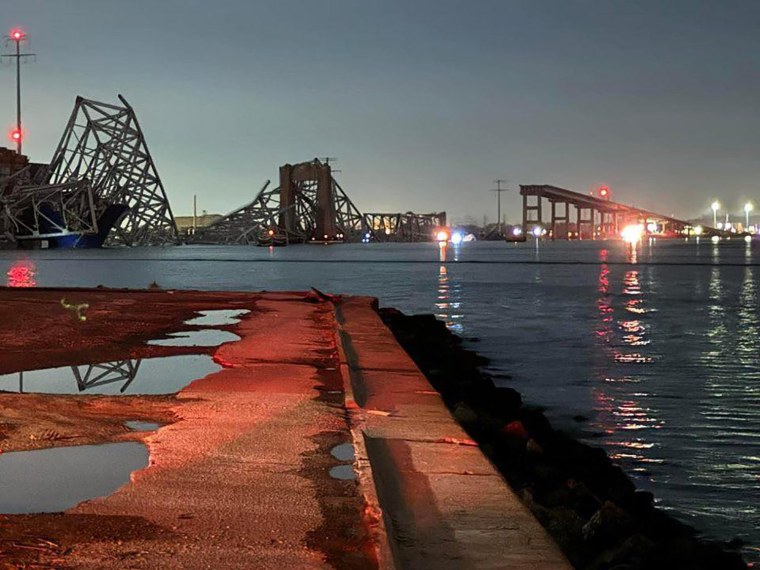
Bobby Haines, who lives in Dundalk in Baltimore County, said he felt the impact of the bridge collapse from his house nearby.
"I woke up at 1:30 this morning and my house shook, and I was freaking out," he said. "I thought it was an earthquake, and to find out it was a bridge is really, really scary."
Families of bridge workers wait for updates
Earlier in the day, relatives of the construction crew waited for updates on their loved ones.
Marian Del Carmen Castellon told Telemundo her husband, Miguel Luna, 49, was working on the bridge.
“They only tell us that we have to wait and that they can’t give us information,” she said.
Castellon said she was "devastated, devastated because our heart is broken, because we don’t know how they have been rescued yet. We are just waiting for the news."
Luna's co-worker Jesús Campos said he felt crushed, too.
“It hurts my heart to see what is happening. We are human beings, and they are my folks,” he said.
Campos told The Baltimore Banner that the missing men are from El Salvador, Guatemala, Honduras and Mexico.
Active search and rescue ends
The Coast Guard said it was suspending the active search-and-rescue effort at 7:30 p.m. Tuesday.
"Coast Guard’s not going away, none of our partners are going away, but we’re just going to transition into a different phase," Gilreath said at a news conference.
Maryland State Police Superintendent Roland L. Butler, Jr., said it was moving to a recovery operation. Changing conditions have made it dangerous for divers, he said.
Butler pledged to "do our very best to recover those six missing people," but the conditions are difficult.
"If we look at how challenging it is at a simple motor vehicle crash to extract an individual, I'm sure we can all imagine how much harder it is to do it in inclement weather, when it's cold, under the water, with very limited to no visibility," he said.
"There's a tremendous amount of debris in the water," which can include sharp metal and other hazards, and that could take time, Butler said.
'A long road in front of us'
Built in 1977 and referred to locally as the Key Bridge, the structure was later named after the author of the American national anthem.
The bridge is more than 8,500 feet long, or 1.6 miles. Its main section spans 1,200 feet, and it was one of the longest continuous truss bridges in the world upon its completion, according to the National Steel Bridge Alliance .
About 31,000 vehicles a day use the bridge, which equals 11.3 million vehicles per year, according to the Maryland Transportation Authority.
The river and the Port of Baltimore are both key to the shipping industry on the East Coast, generating more than $3.3 billion a year and directly employing more than 15,000 people.
Asked what people in Baltimore can expect going forward, the state's transportation secretary said it is too early to tell.
"Obviously we reached out to a number of engineering companies, so obviously we have a long road in front of us," Wiedefeld said.
Julia Jester reported from Baltimore, Patrick Smith from London, Corky Siemaszko from New York and Phil Helsel from Los Angeles.
Julia Jester is a producer for NBC News based in Washington, D.C.
Patrick Smith is a London-based editor and reporter for NBC News Digital.
Phil Helsel is a reporter for NBC News.
Corky Siemaszko is a senior reporter for NBC News Digital.

IMAGES
VIDEO
COMMENTS
The Improved Outboard Well. Replacing an inboard engine with a tilt-up. outboard in a custom-built well. Atom's extra-long-shaft outboard motor places the shaft nearly as low as the original prop in its aperture. My 28-foot Pearson Triton, Atom, has undergone several extensive refits during our 40 years and two circumnavigations together.
So I kept the motor well simple: a squarish hole in the bottom of a perfectly good boat with raised sides that kept the water out and the outboard supported. ... If I need to move the motor, I simply unscrew the transom clamps and pull the motor out of the well and into the boat! Pretty easy and has worked well. Reply. Kevin Beatley says ...
Lazerbrains. 929 posts · Joined 2015. #15 · Nov 15, 2017. I had a small boat similar to yours with a motor in the well. Short story is that I loved it. For a small boat a 5hp outboard should have no problems getting you to speed, and is much easier to maintain (or replace) than an inboard.
This Alberg 30 has a 9.8hp motor installed in a tilt-up outboard well. The prop is well positioned forward and low so as not to suck air in choppy water and can be tilted up for drag-free sailing. The prop aperture has been filled for low drag and improved rudder efficiency. The Alberg 30 is one of those rare boats that has the perfect shape ...
Hello everyone, this is my first post that involves a question about the design and installation of a motor well in a Grand Banks style dory. I'm a genuine dory fan and owned a 20' Lowell sportsman (should have never sold that boat ) before my current 18' banker.The Lowell had a motor well that included a slot in the counter that allowed full tilt of the outboard for beaching.
Islander 21 Motor Well. There are a few names for a Transom Well, Motor Well, Inboard Outboard Well, Engine Mount Well, and I'm sure there are others. I wanted to post a few more pictures of the engine mount well in my Islander 21′ sailboat for the folks at the Facebook Islander Sailboat Owners group. Here's my old 1967 Johnson 6hp ...
The production boat will be fitted with a deck and sole in one or two parts. In most cases those molded parts will be fitted to the hull with fasteners and sealant. Those parts do not add strength of the typical production boat. In our boats, we will integrate parts like the motor well, sole and deck in the structure to build a stronger and
Part 1 - Step-by-step description of installing an enclosed tilt-up outboard well on a 28' Pearson Triton sailboat.
2-Stroke Engines - This is due to an overall lighter weight engine and higher torque. Diesel Engines - Diesel delivers more torque because the rate of compression is greater. Bigger Propellers - More surface area means more water displacement. Location - Motoring on lakes and rivers requires less power than open ocean.
To get the right amount of horsepower needed to efficiently propel a sailboat, divide the displacement of the boat (in lb) by 550. You need approximately 1 HP per 550 lb of displacement or 4 HP per 2200 lb. Most sailboats don't need a motor with more than 30 HP. In this article, I'm talking about small outboard engines for sailboats.
With the Spirit 1.0 Evo electric sailboat motor, you can go 5.5 mph (8.8 kph) at top speed on the 21 ft RS21 sailing boat, or troll for 20 hours continuously at 2.2 mph (3.5 kph) according to our test. This electric sailboat motor with regeneration allows you to recover energy from the prop while under sail.
Honda for example offers 20 and 25-inch transom height (long or short shaft) right down to their smallest BF2 (two-horsepower) model. Mercury and Mariner only offer a 15-inch short-shaft version ...
The motor size required for your boat depends on several factors, primarily the vessel's size, weight, and operating conditions (such as currents, open sea, tides). User preference is also a consideration. As a rule of thumb, for displacement vessels, 1kW of electric power can replace approximately 3HP of diesel power. ...
Custom-built upright motor well. Since cutting a hole in the bottom of a boat does reduce a dory's freeboard - that is, the boat above the waterline - and installing the old-fashioned tip- up well also takes up a certain amount of interior space, there are those who prefer to keep the footprint of their well as small as possible.
20′ Banks Fishing Dory, USCG - Outboard Motor Well. Today I nearly worked all day calculating the outboard motor well. What is left to design and build is the removable tunnel baffle that will start at the bottom "V" of the motor well and come up to the bottom of the rear notch. This will force the prop wash to propel the boat naturally.
35 feet 7.9 knots (9.1mph) With an electric outboard motor, or any kind of auxiliary motor, boat speed depends on the hull type, waterline length, and total displacement weight (including passengers, food, and baggage), as well as the motor thrust. Speed factors also include the waves, current, and wind, relative to your heading.
Inboard electric sailboat motors are well-suited for larger vessels, including cruising sailboats, pleasure yachts, and some commercial vessels. These boats benefit from the quiet operation and zero emissions of electric inboards. Having the motor within the boat also means better weight distribution, which can enhance stability and performance.
Having the motor tilt would require slotting the transom as well as the bottom of the boat and the motor would be exposed and that could cause problems. The box I'm not too worried about building because I will probably be adding a mizzen mast to make her into a yawl. Getting the control cables to articulate the 30 inches or so might be ...
Most modern sailboats have motors. The type of motor depends on the age of the boat, the size of the vessel, and its purpose. However, there is a class sailboat called a motorsailer. It has an engine that can move it along at speed without the sails, or only the sails can propel it. Many older motorsailer designs don't do very well at either ...
In this article, well explore the different types of motorized sailboats, the benefits of adding a motor to a sailboat, and the pros and cons of using a motor. Well also discuss the installation process and maintenance of a motorized sailboat. So if youre considering giving your sailboat a motor, read on!
Your vessel, reborn. Every enjoyable journey at sea starts with reliable power. Fitting your sailboat with an entirely new Volvo Penta engine, or upgrading your existing one with Volvo Penta sailboat repowering kits, is the best way to make every voyage as magical as you want it to be. Explore repowering options.
The bridge passed inspection in May 2022, but there was concern with one of its columns. The reinforced concrete column was downgraded from a health index, or condition rating, of 77.8 to 65.9. It ...
In honor of this milestone, AACF is calling upon automotive aftermarket industry professionals, as well as compassionate individuals eager to lend a helping hand, to join forces in raising $65,000. By making a symbolic donation of $65, supporters can contribute to a fund that offer vital assistance during a time of greatest need.
Automakers, most of which reported U.S. sales numbers Tuesday, sold nearly 3.8 million vehicles in the first quarter versus a year ago, for an annual rate of 15.4 million in sales.
Earlier, the Coast Guard said it had received a report that a "motor vessel made impact with the bridge" and confirmed it was the Dali, a containership sailing under a Singaporean flag that ...